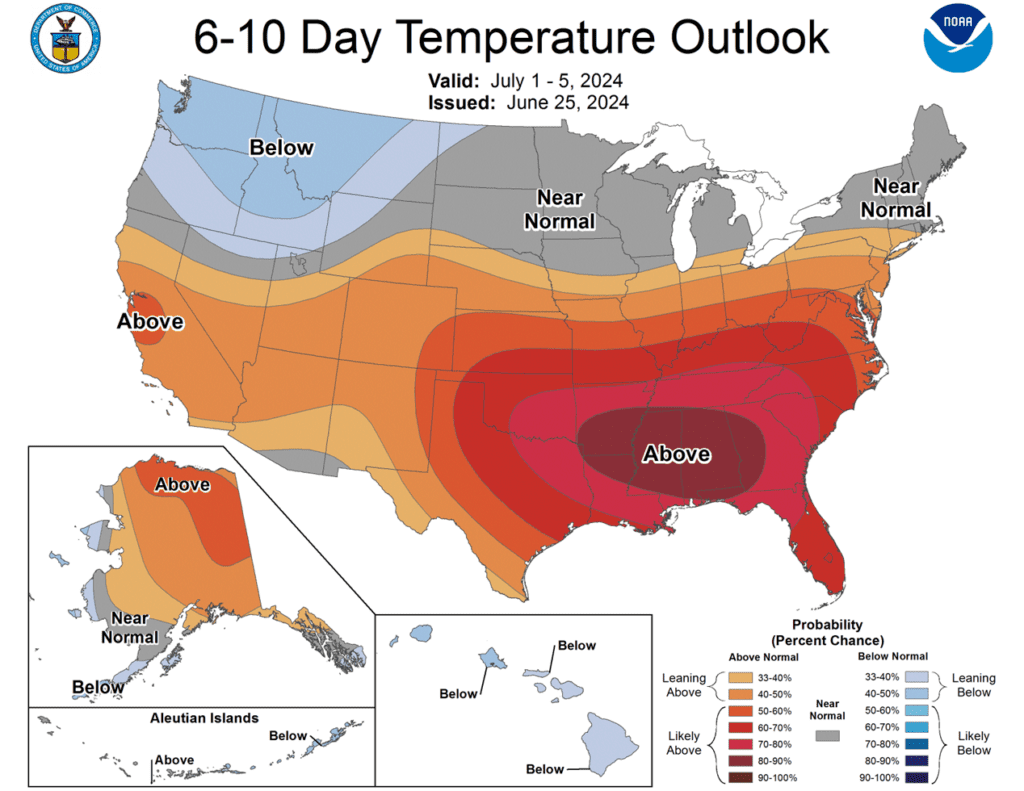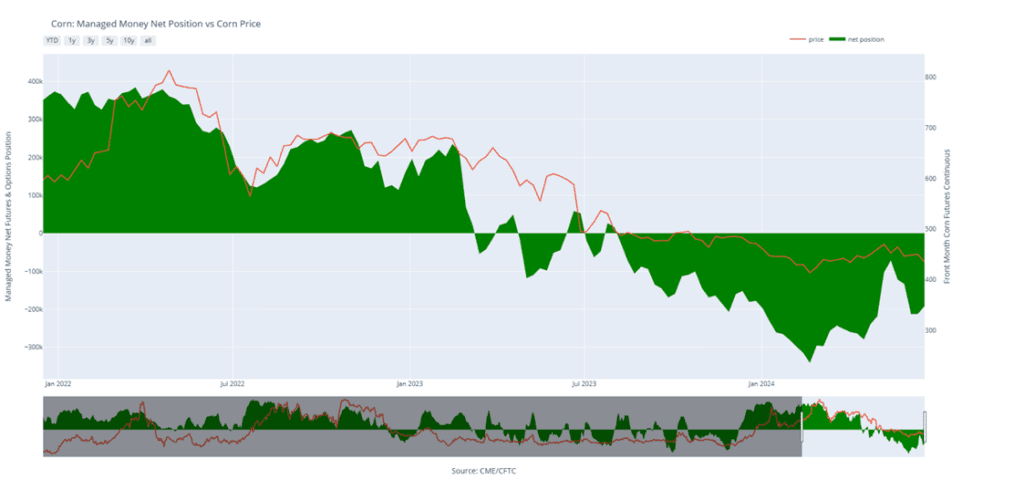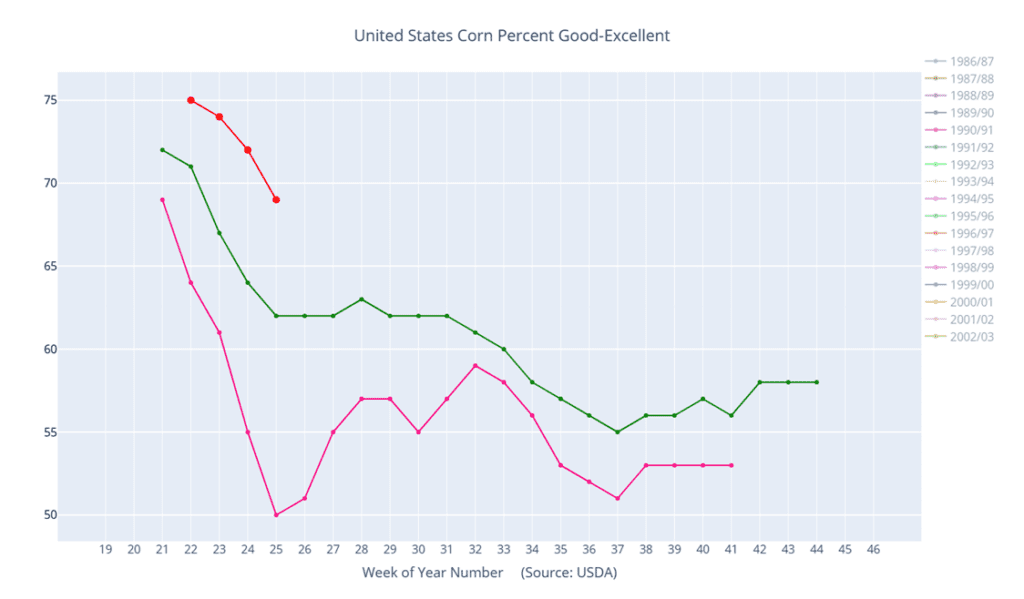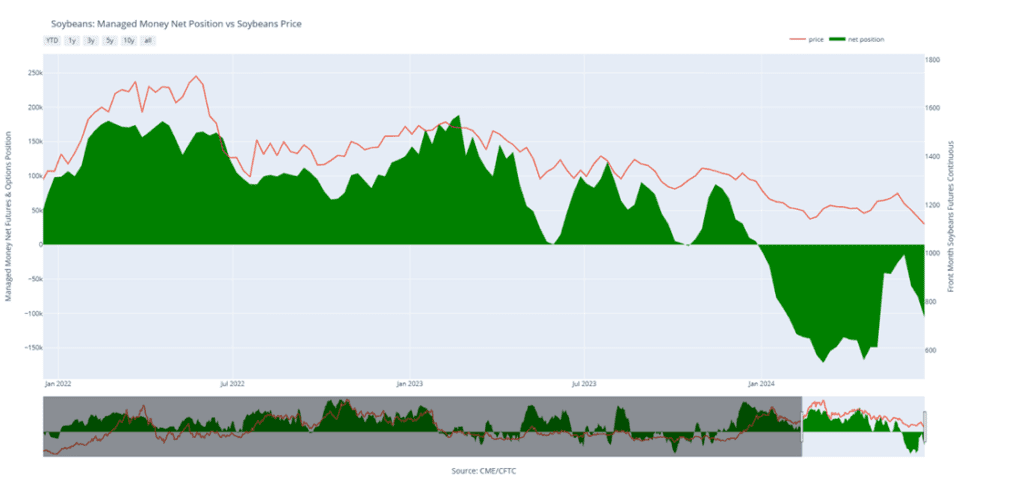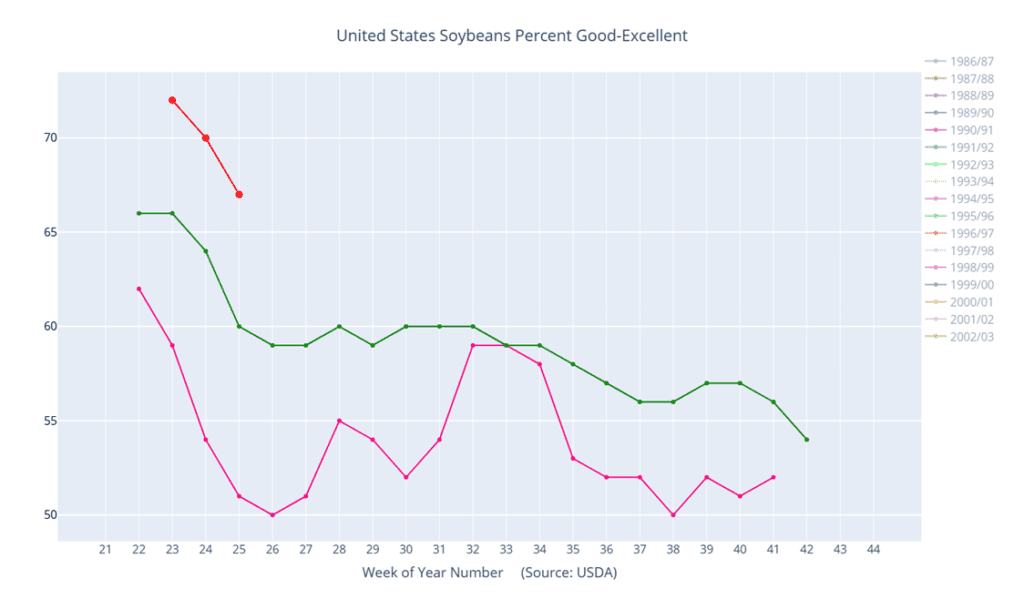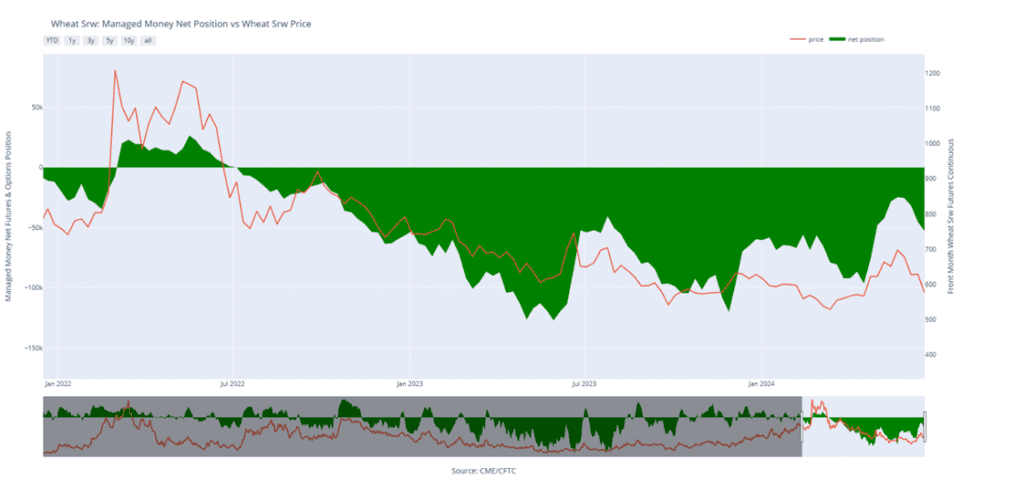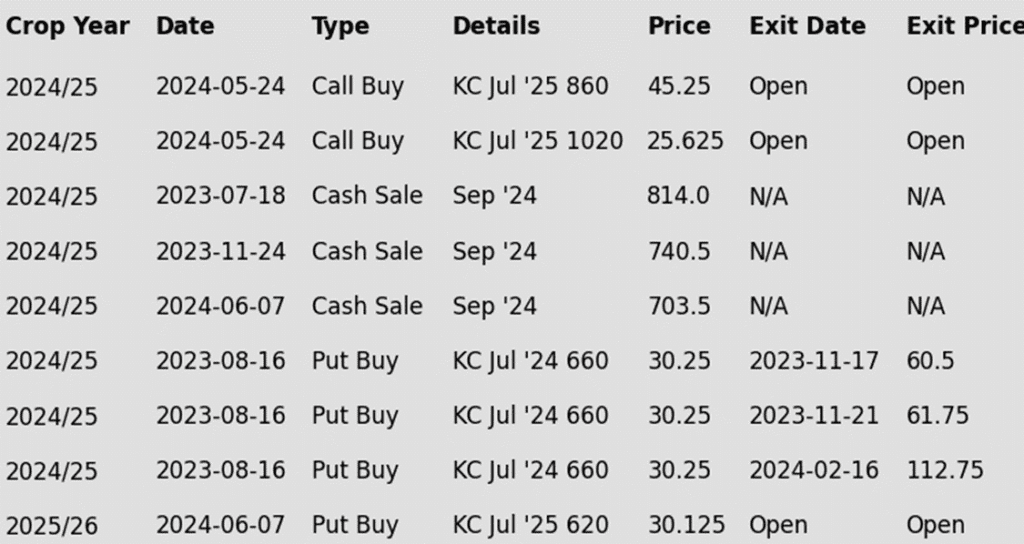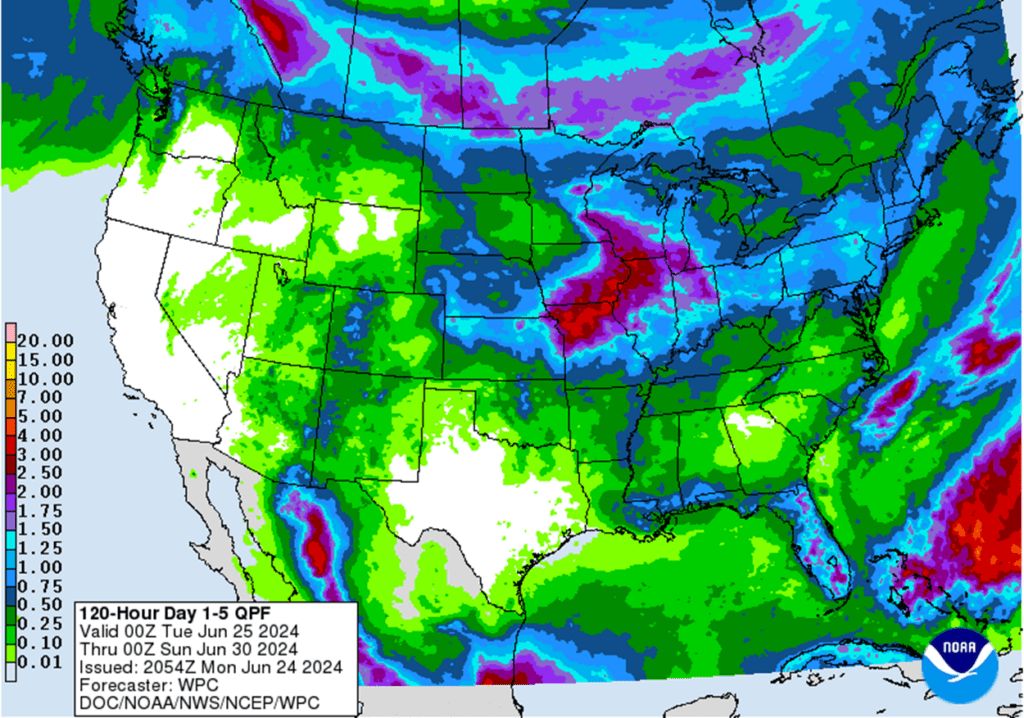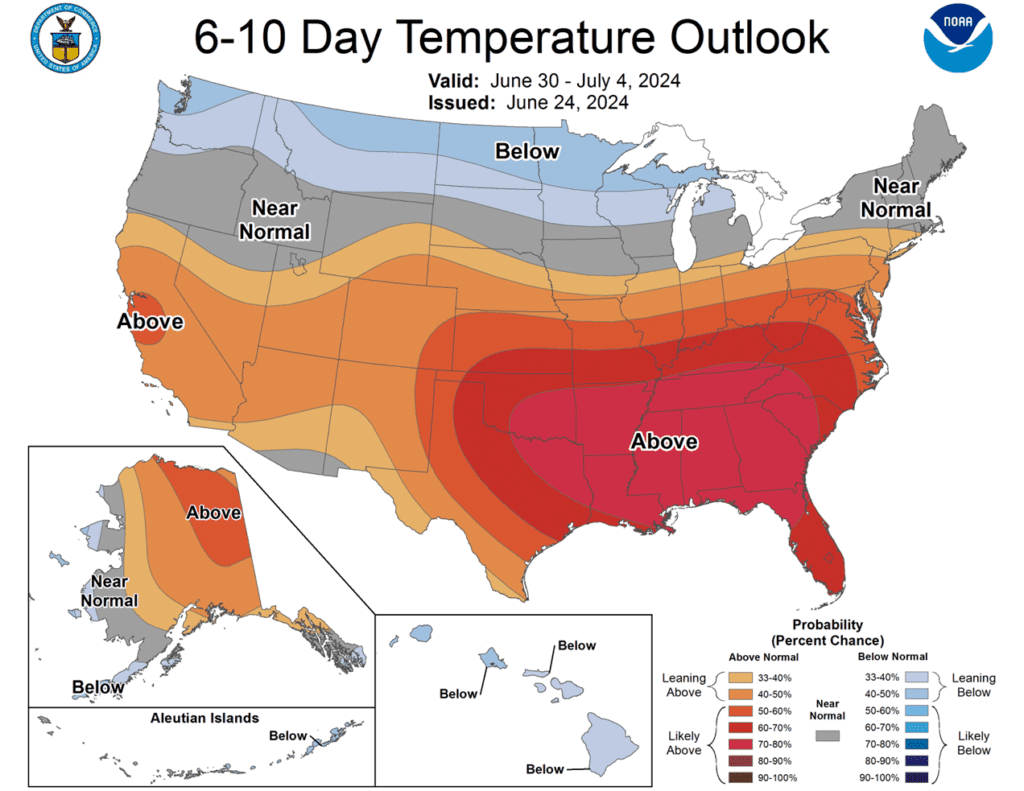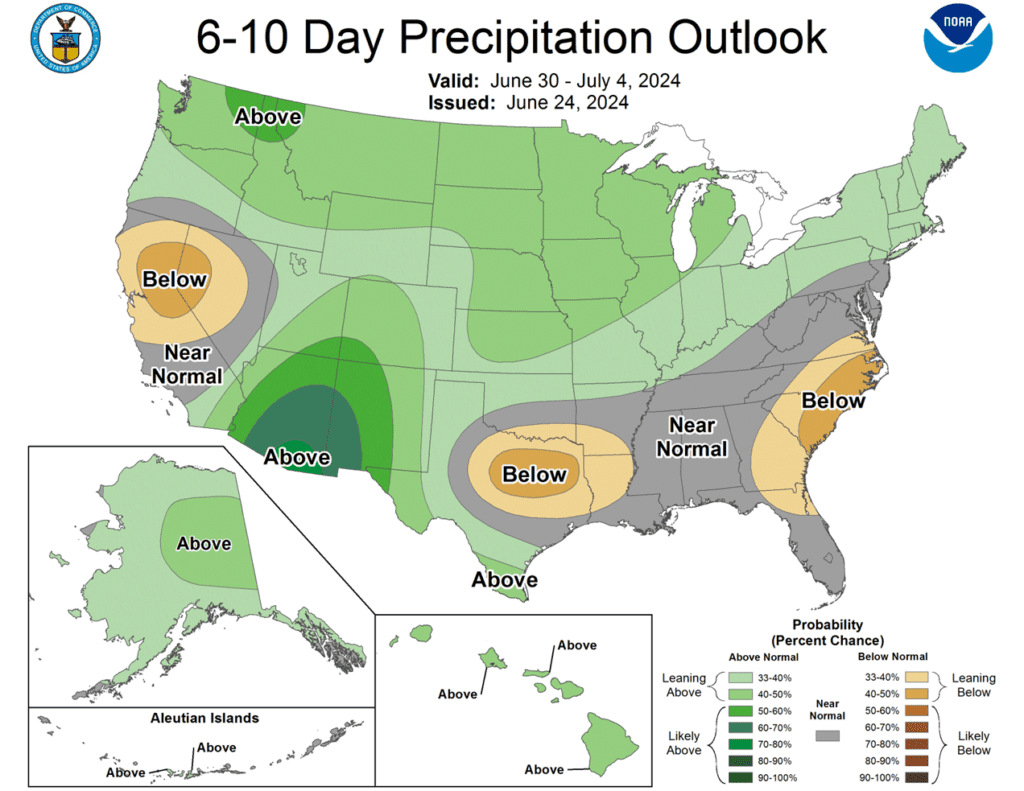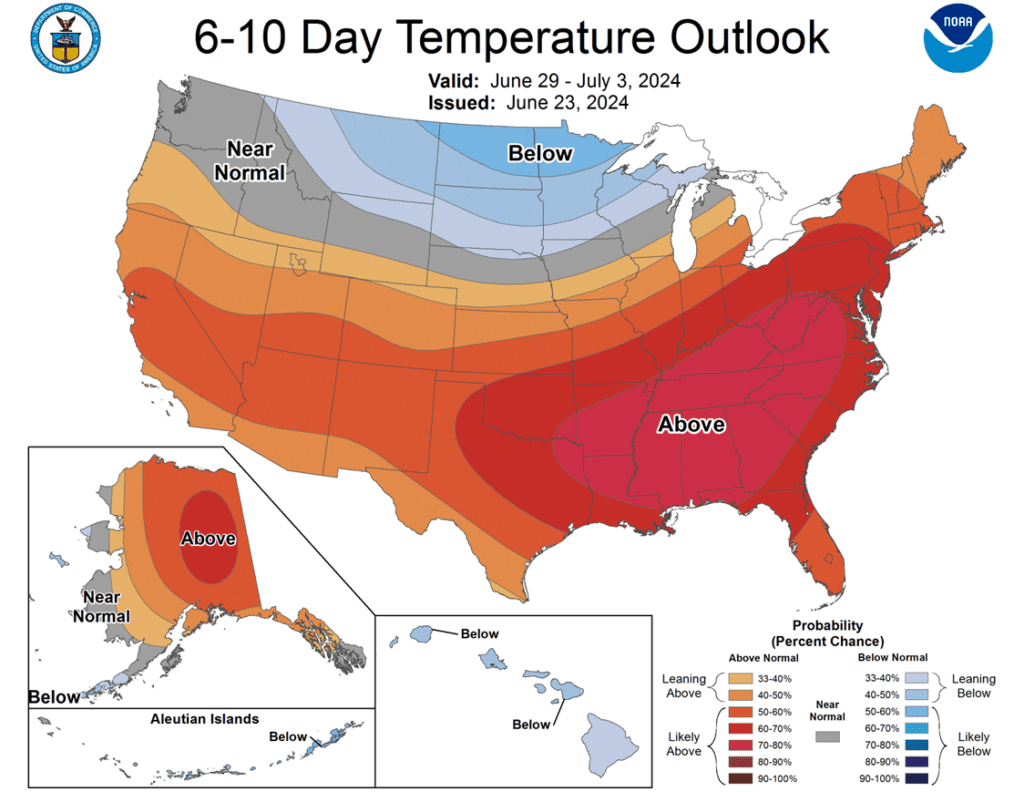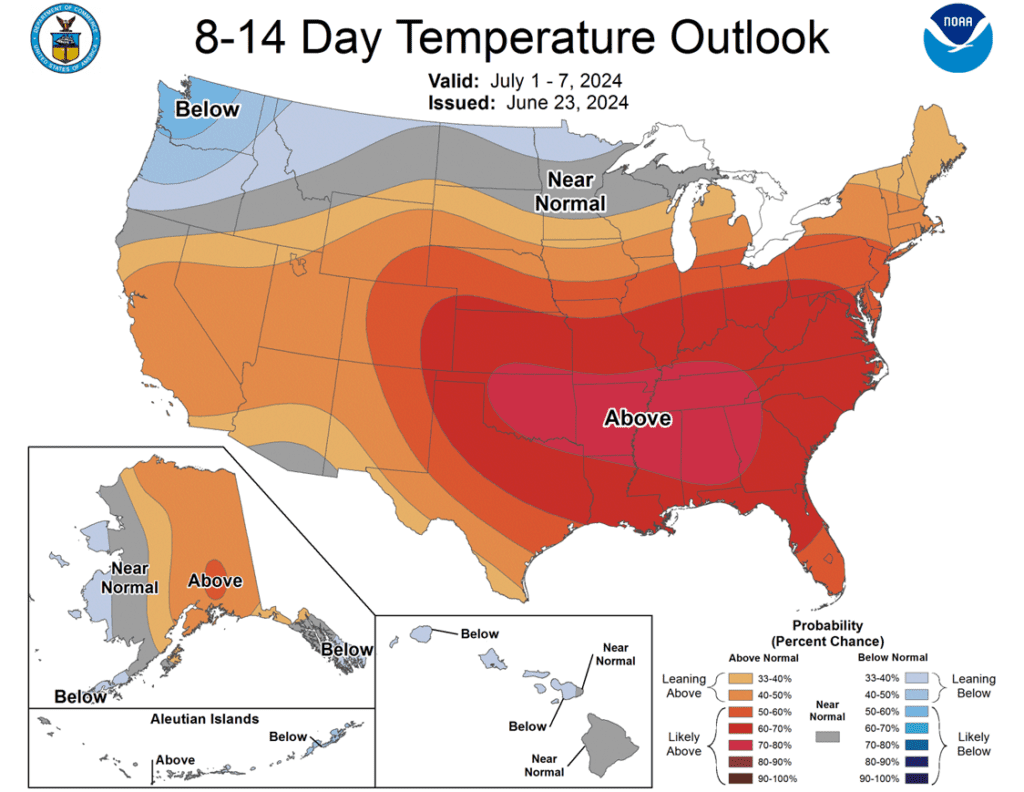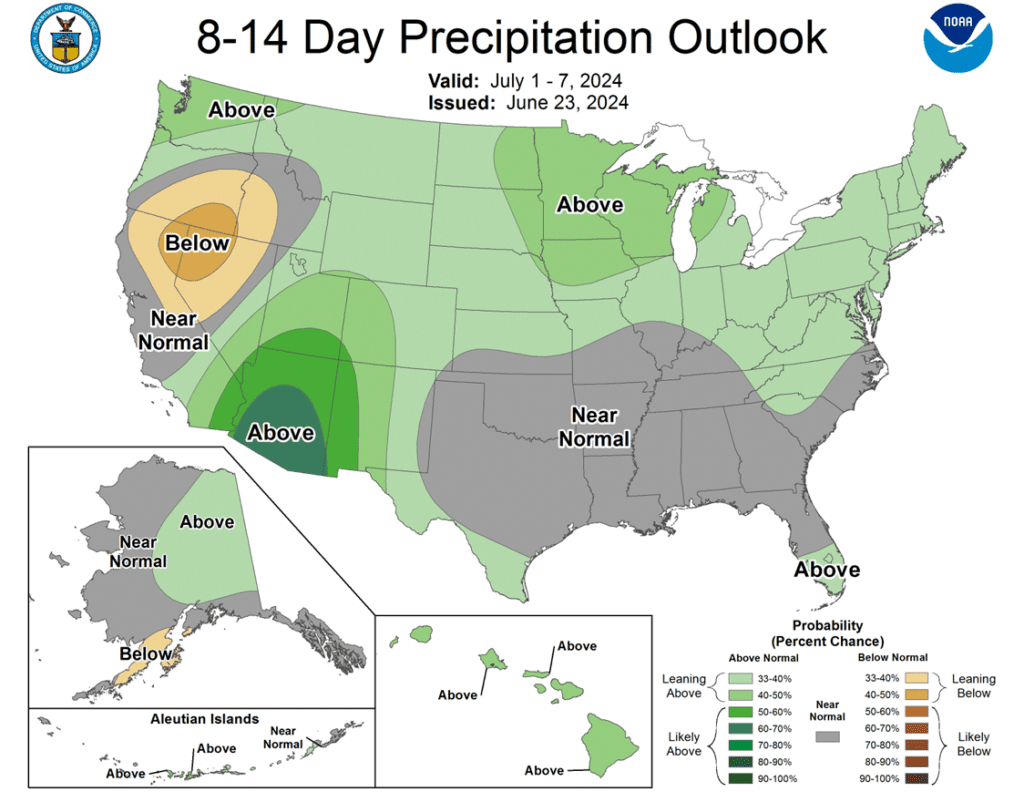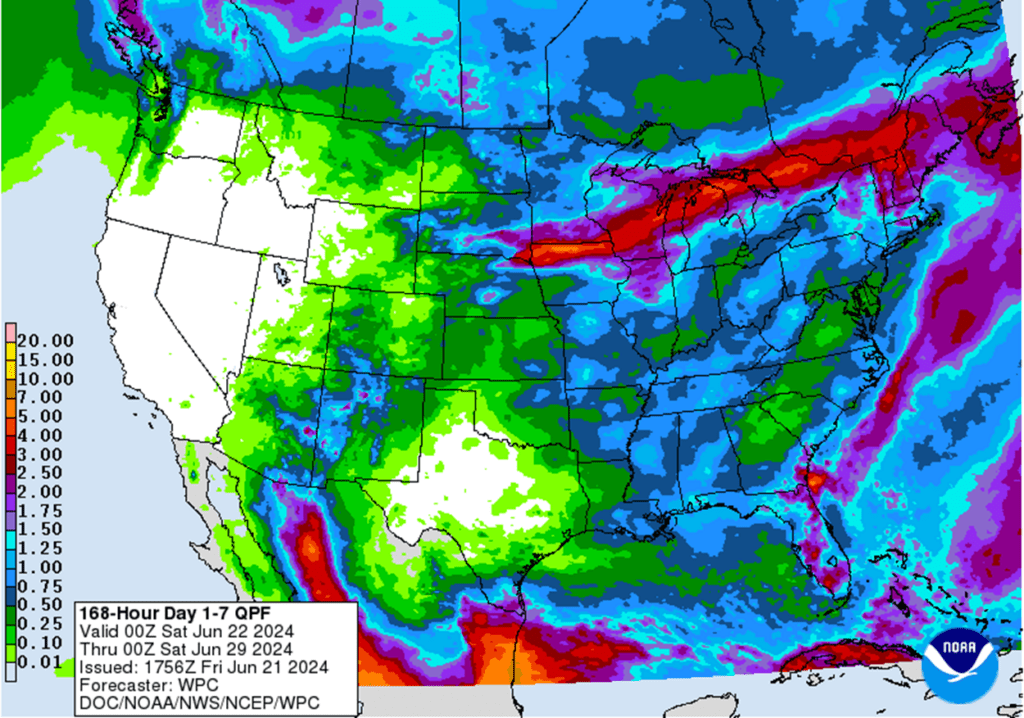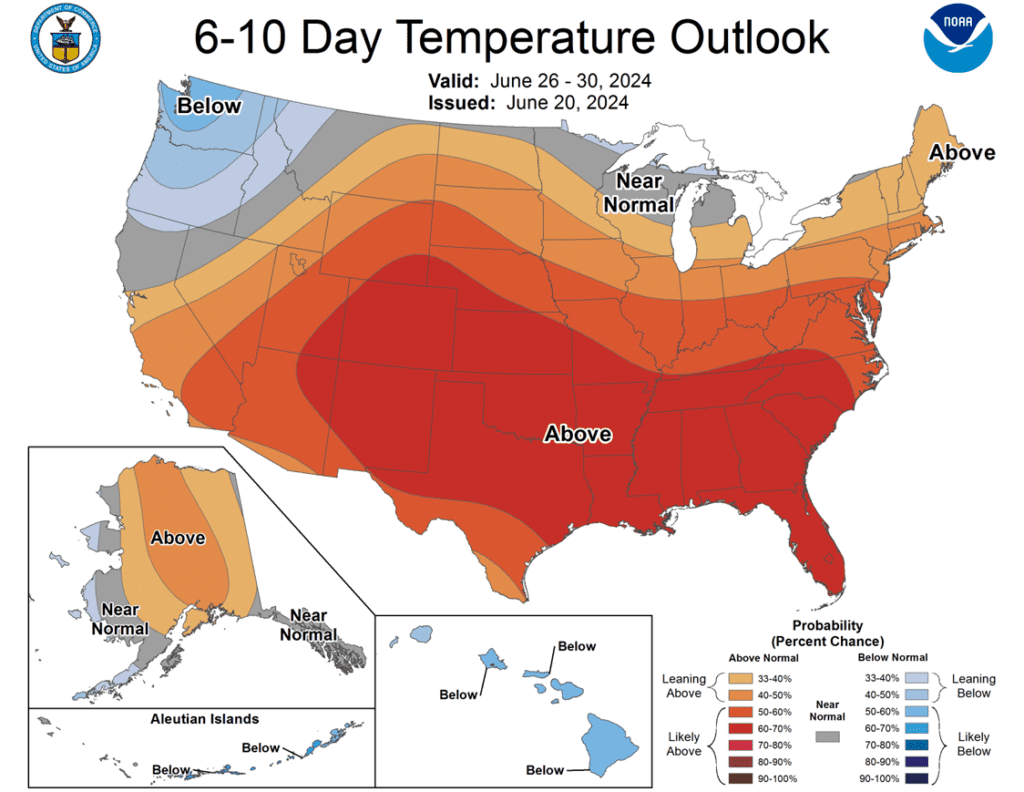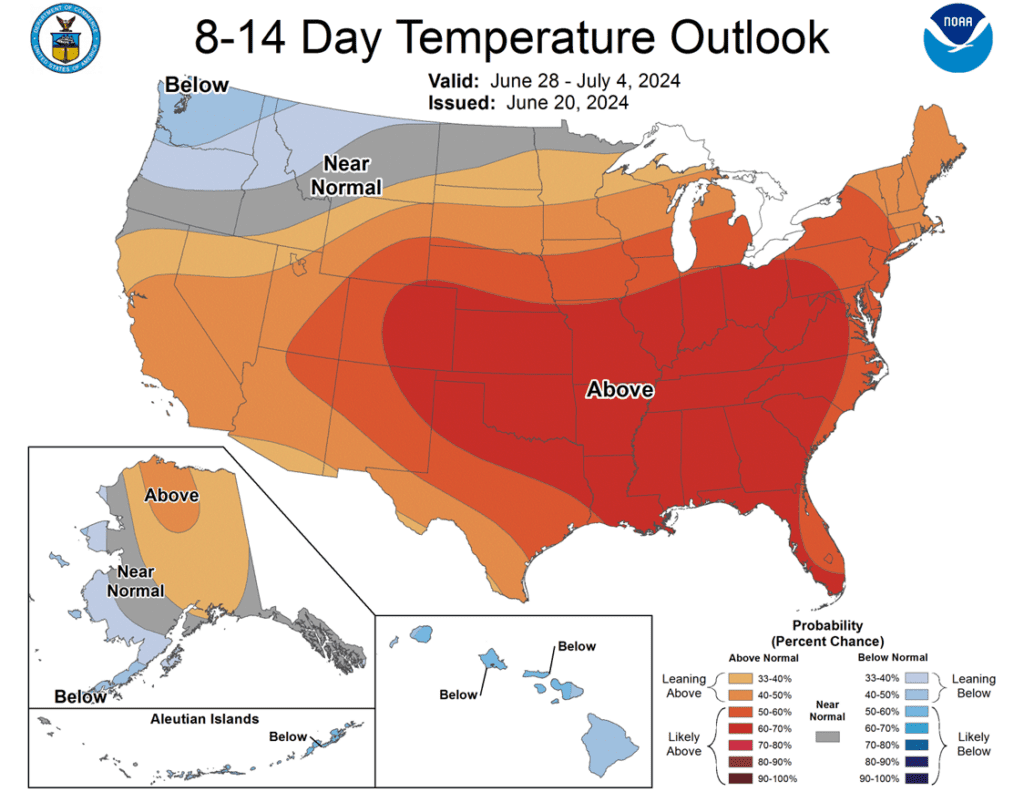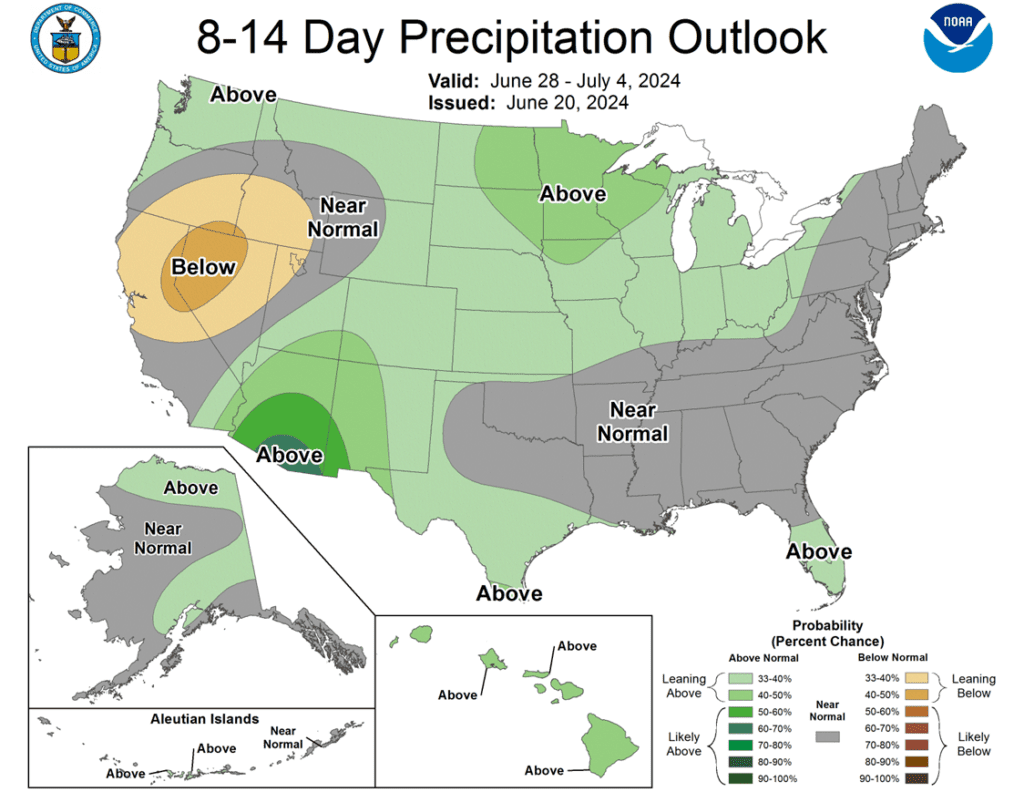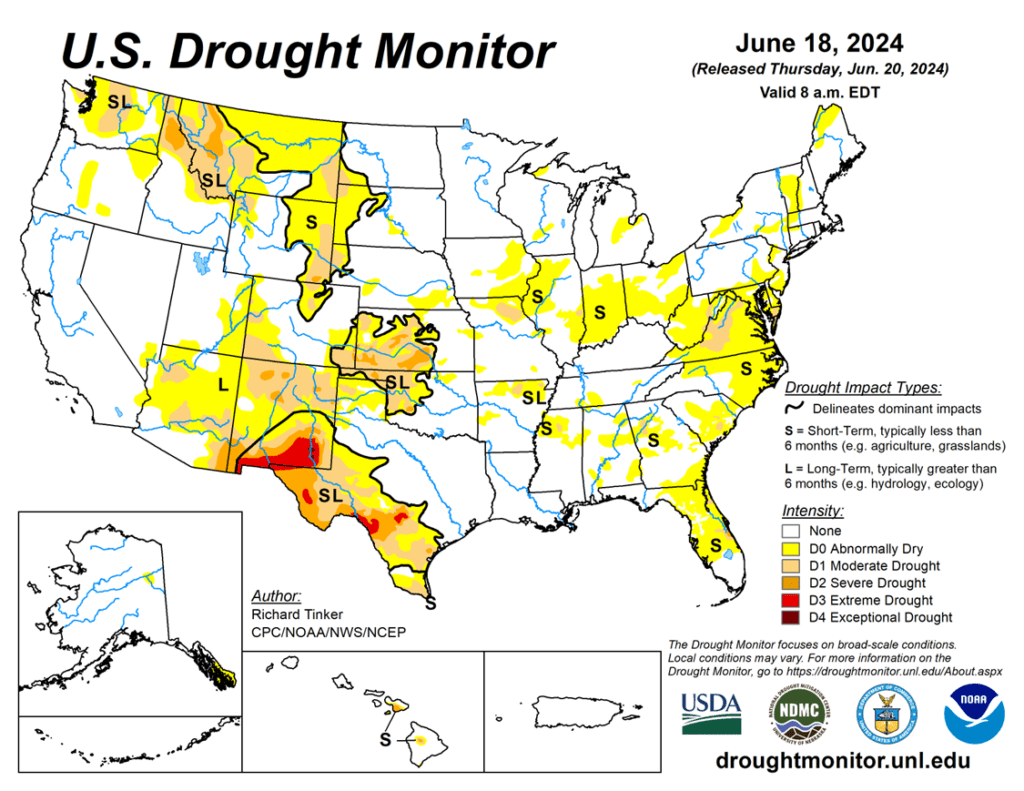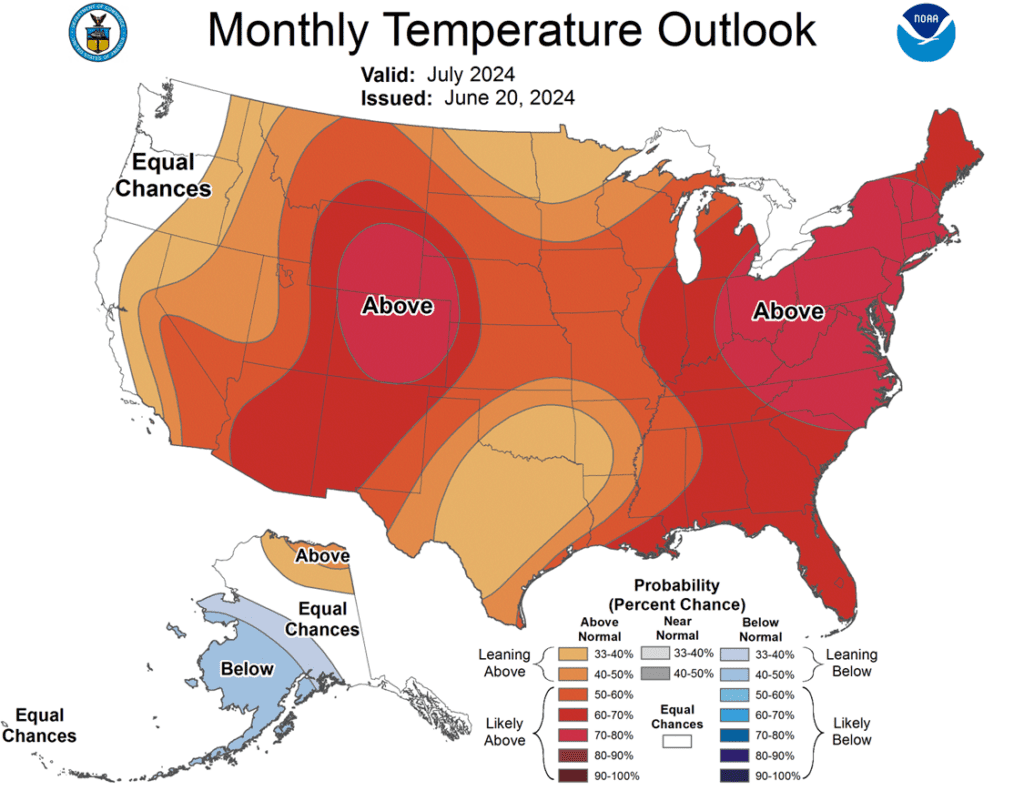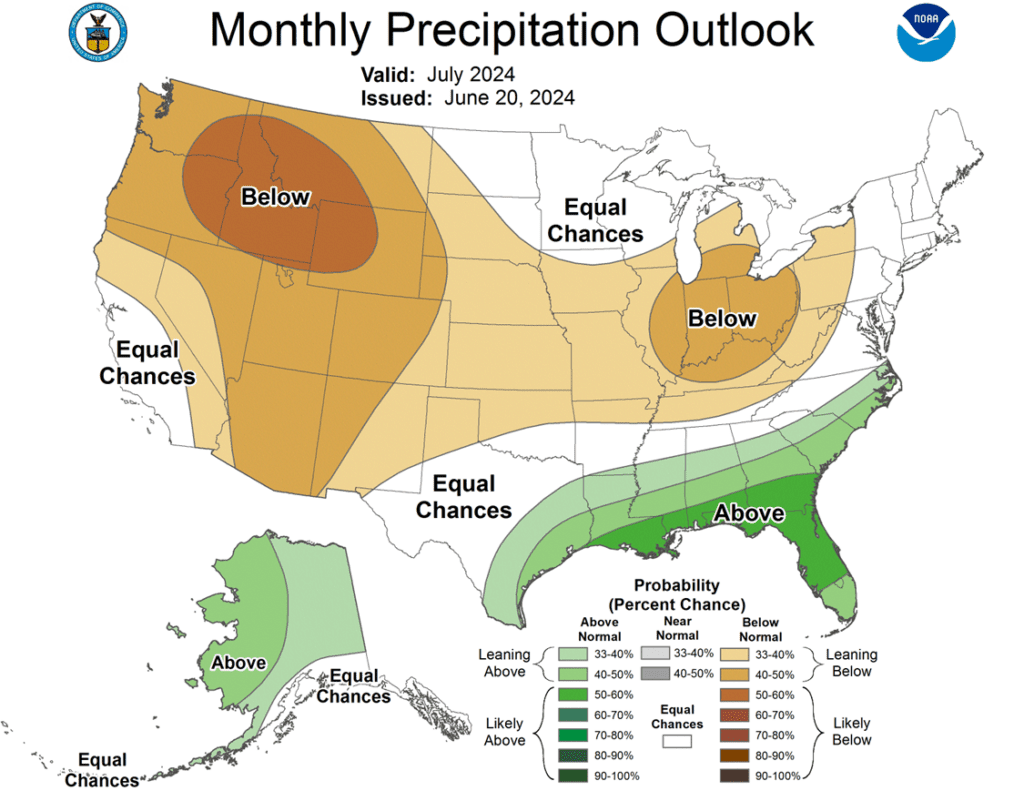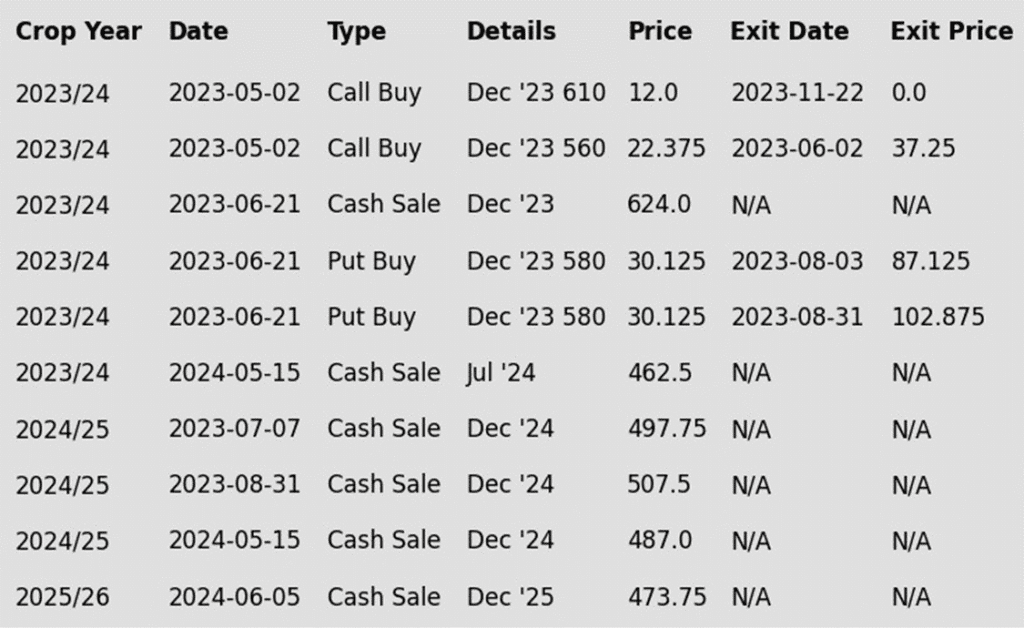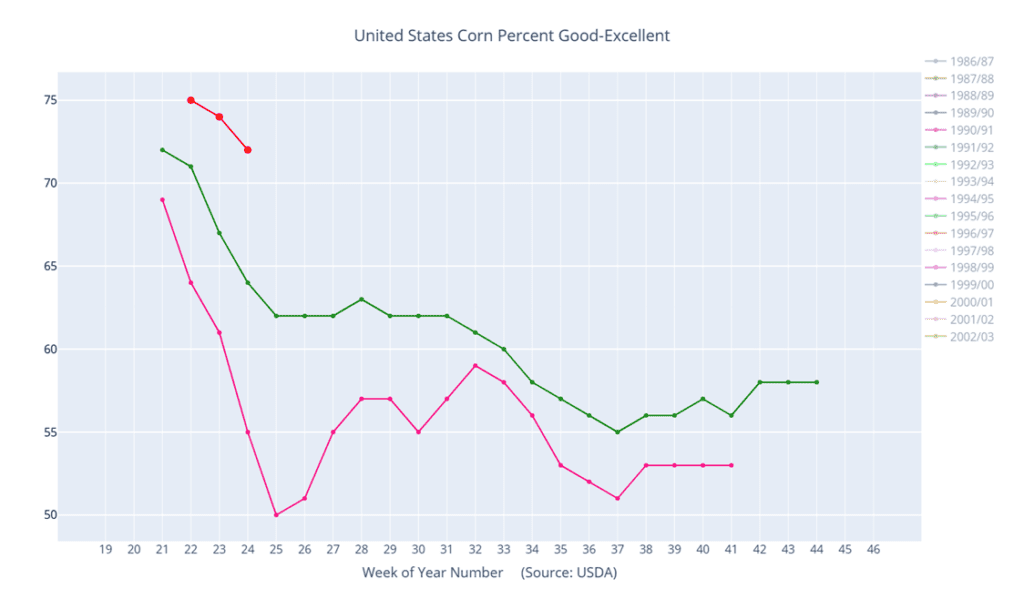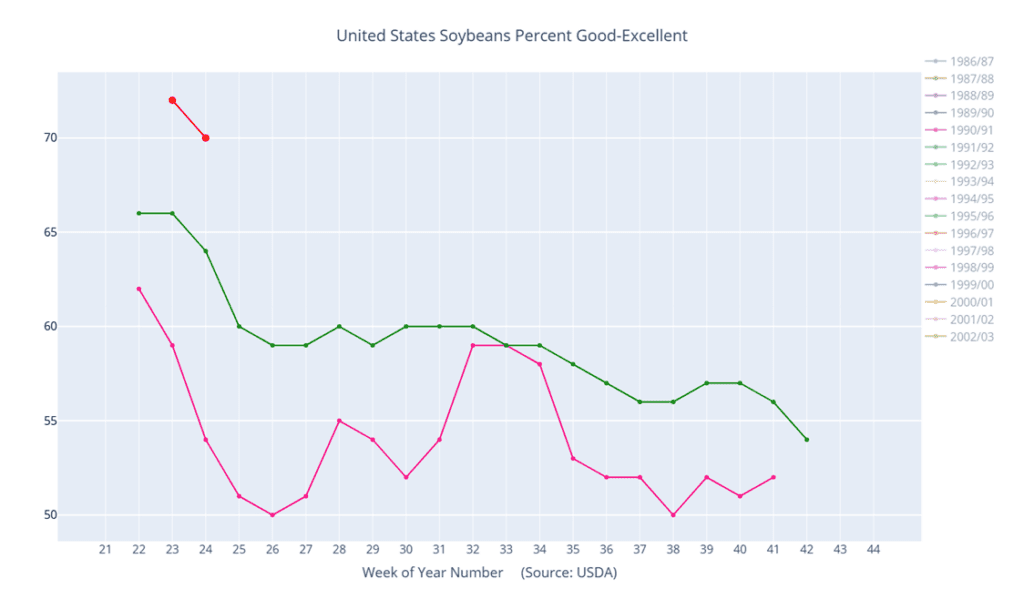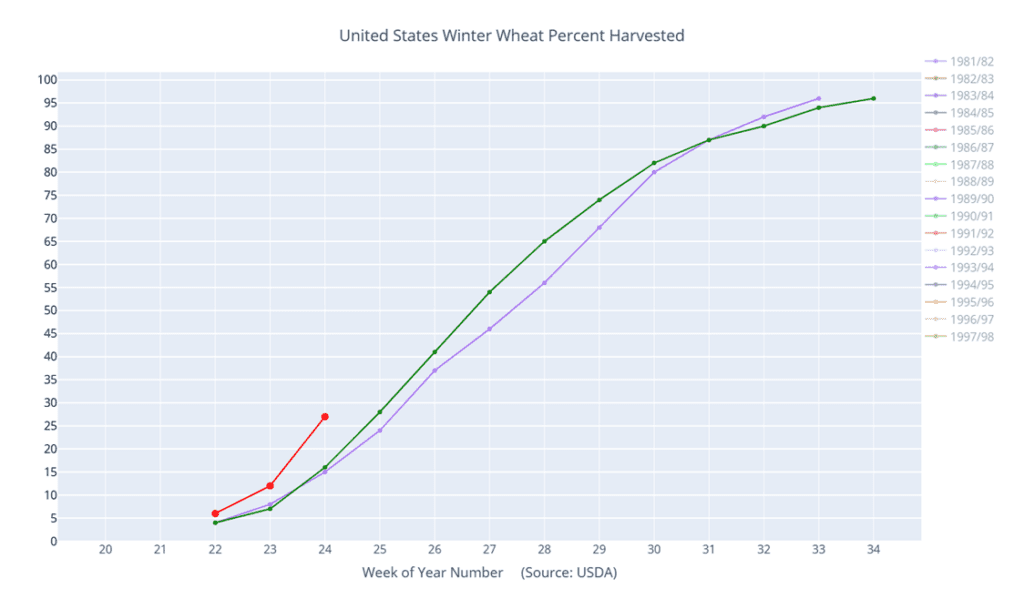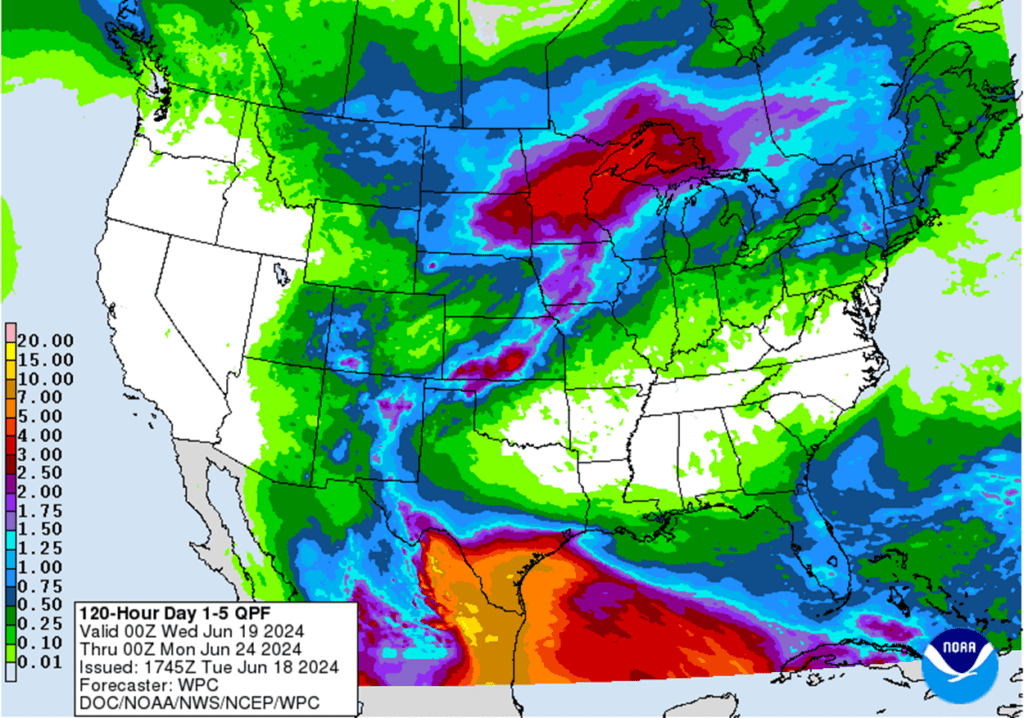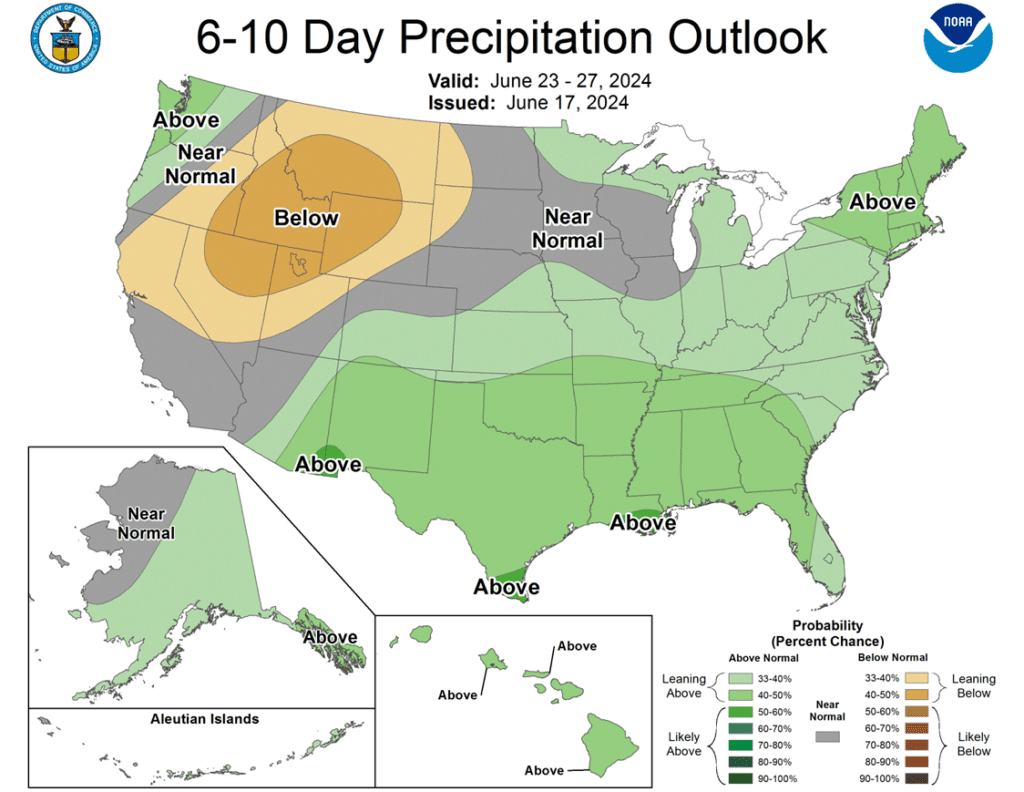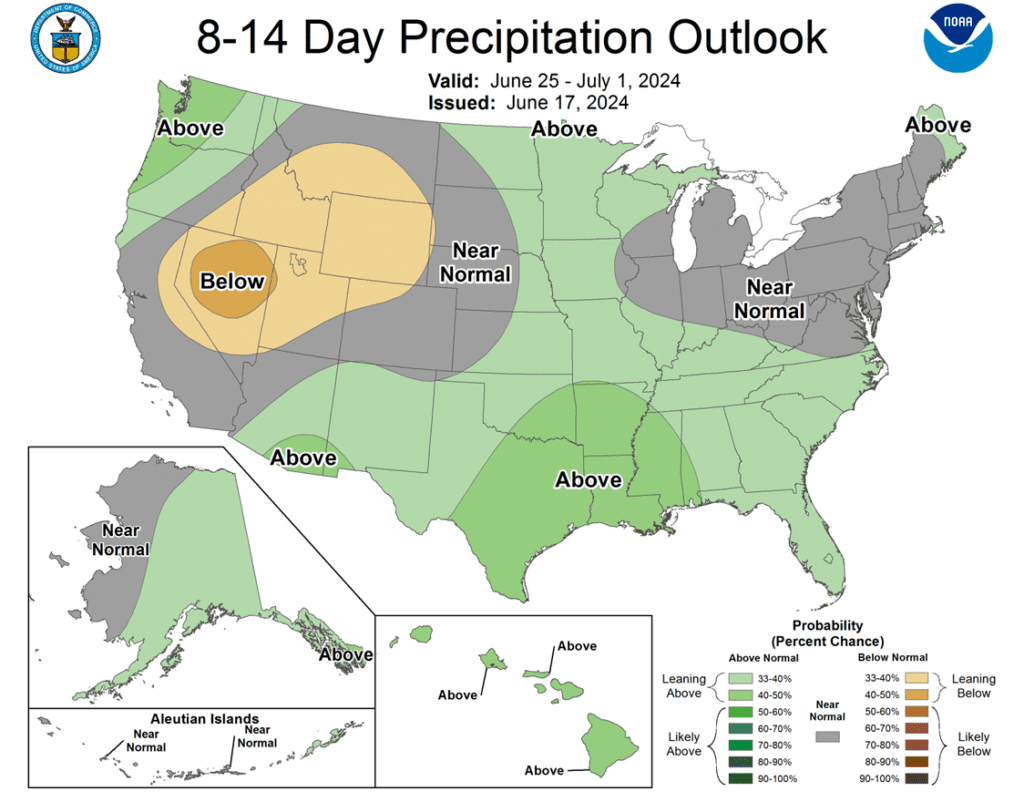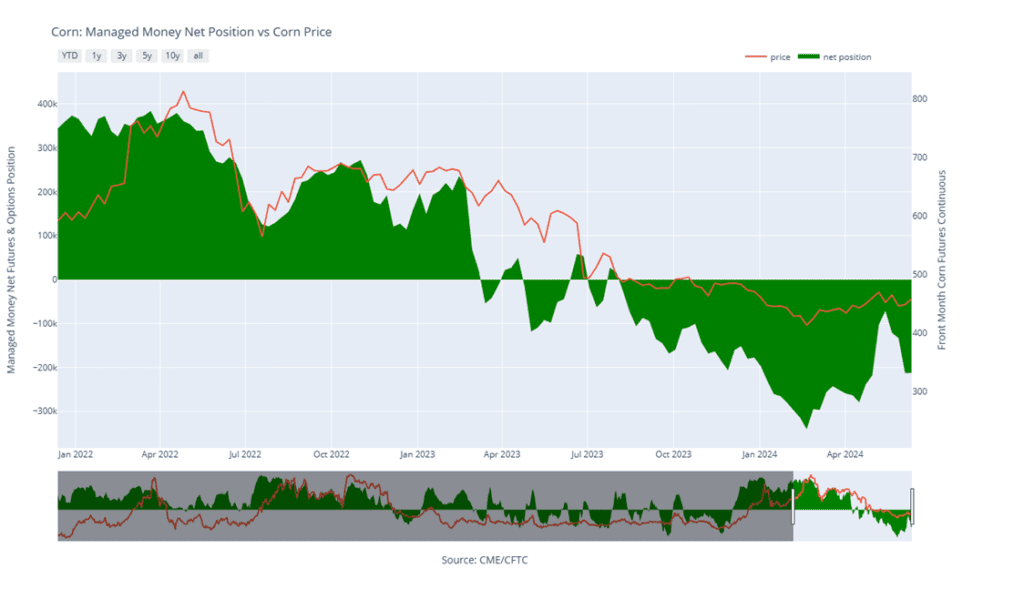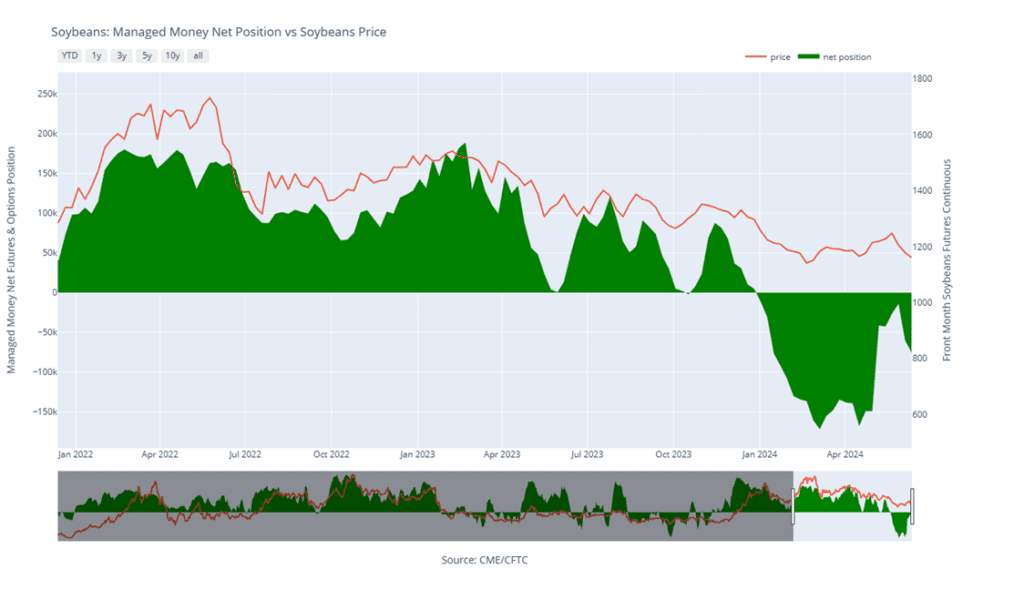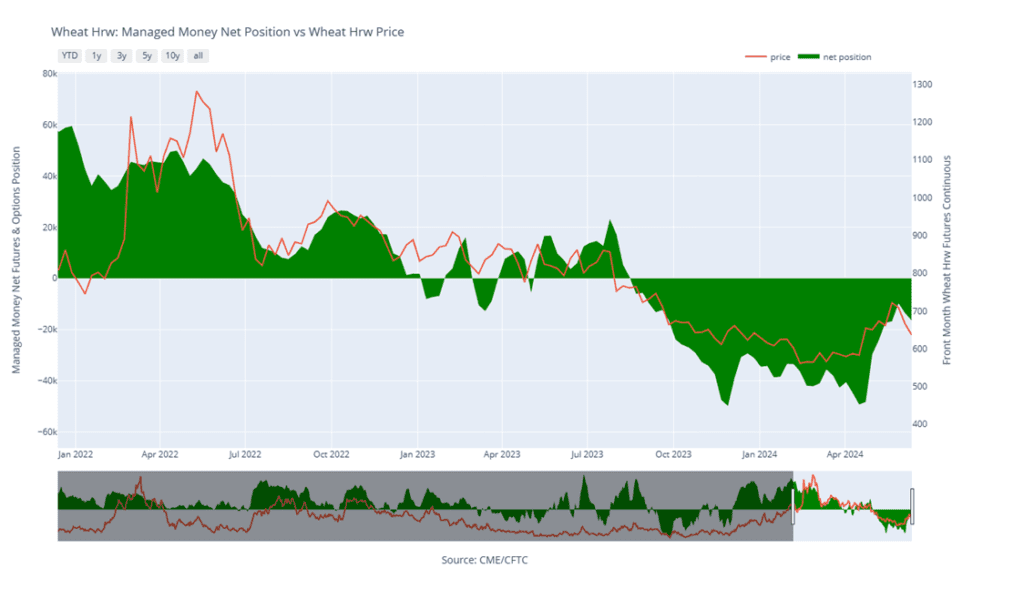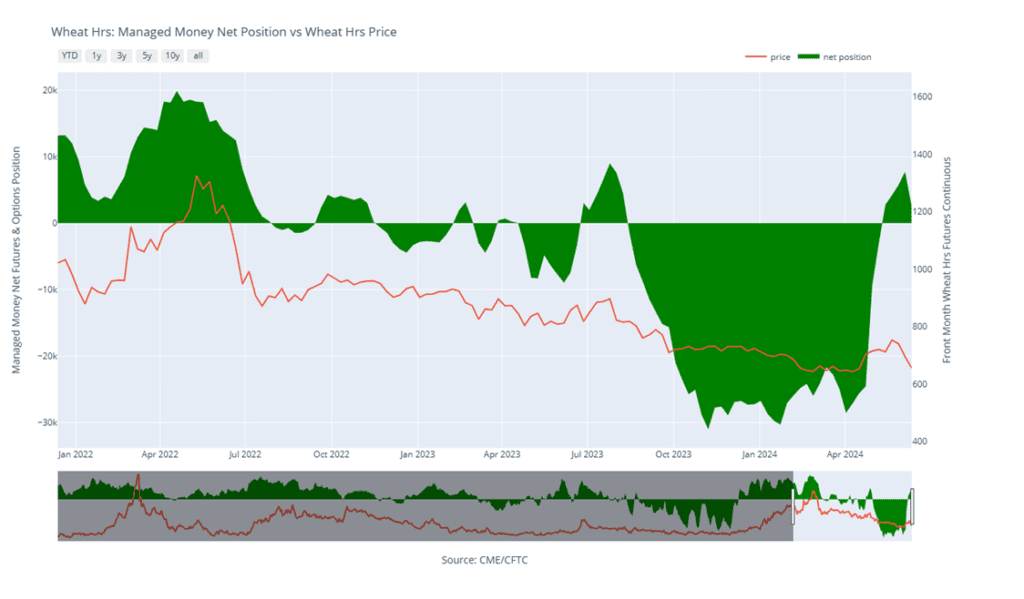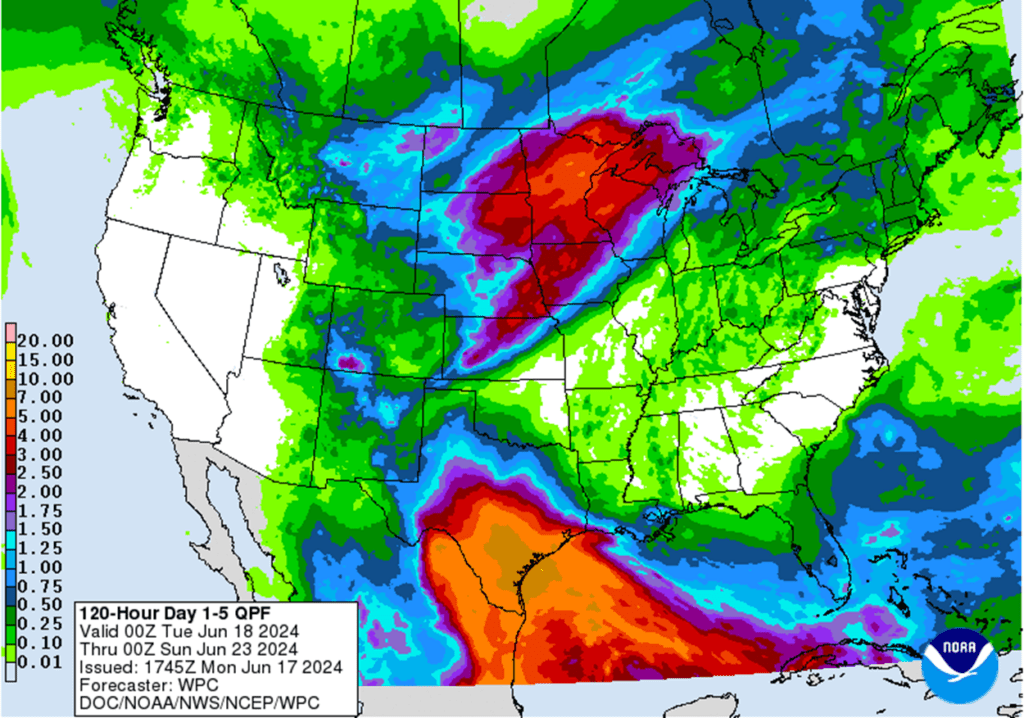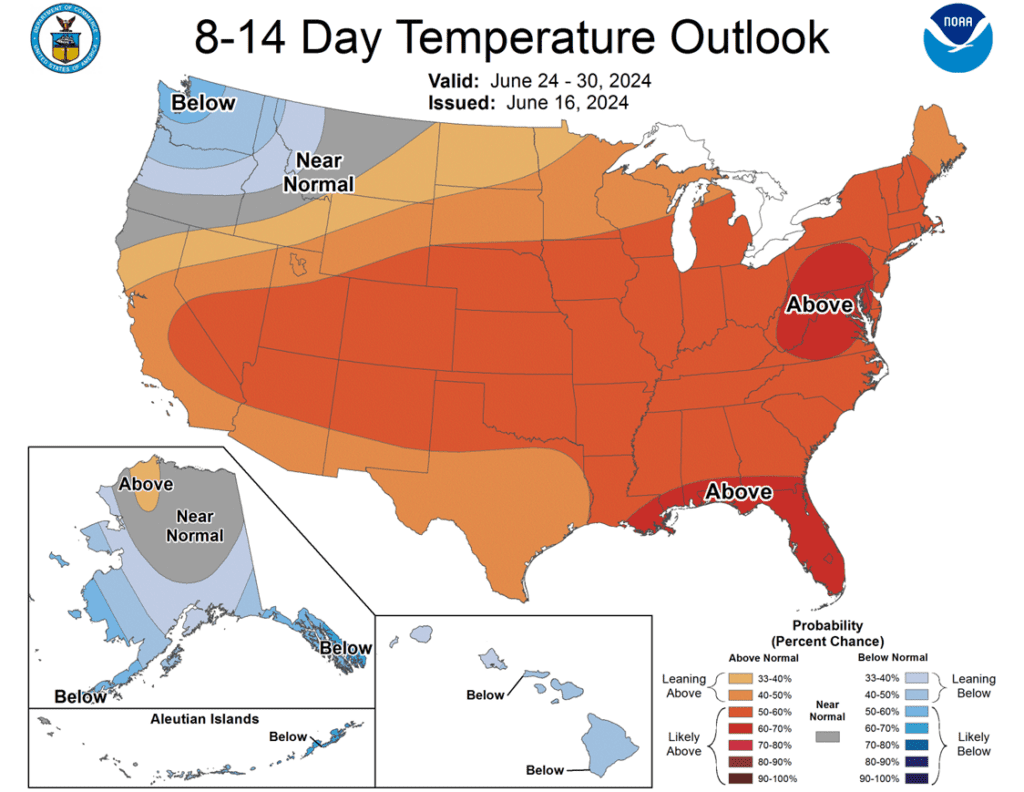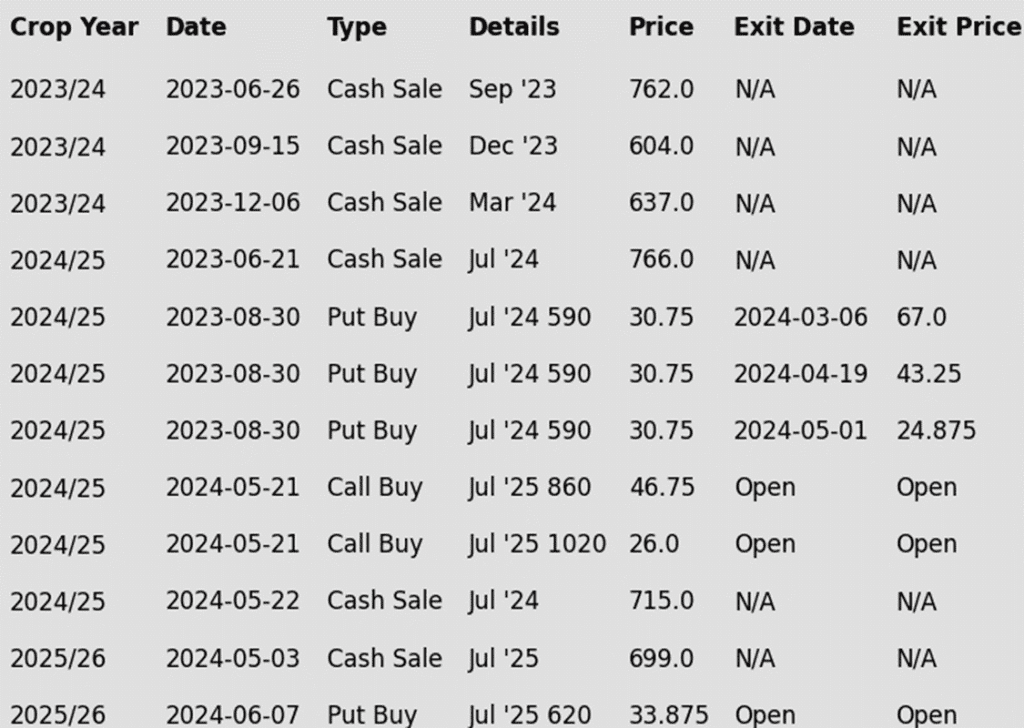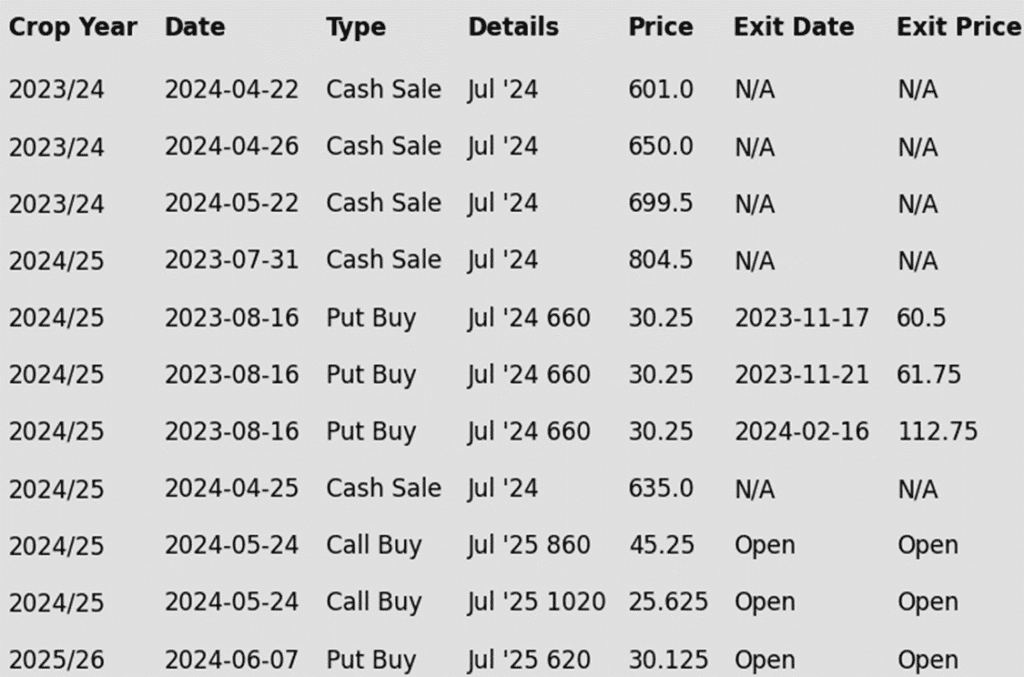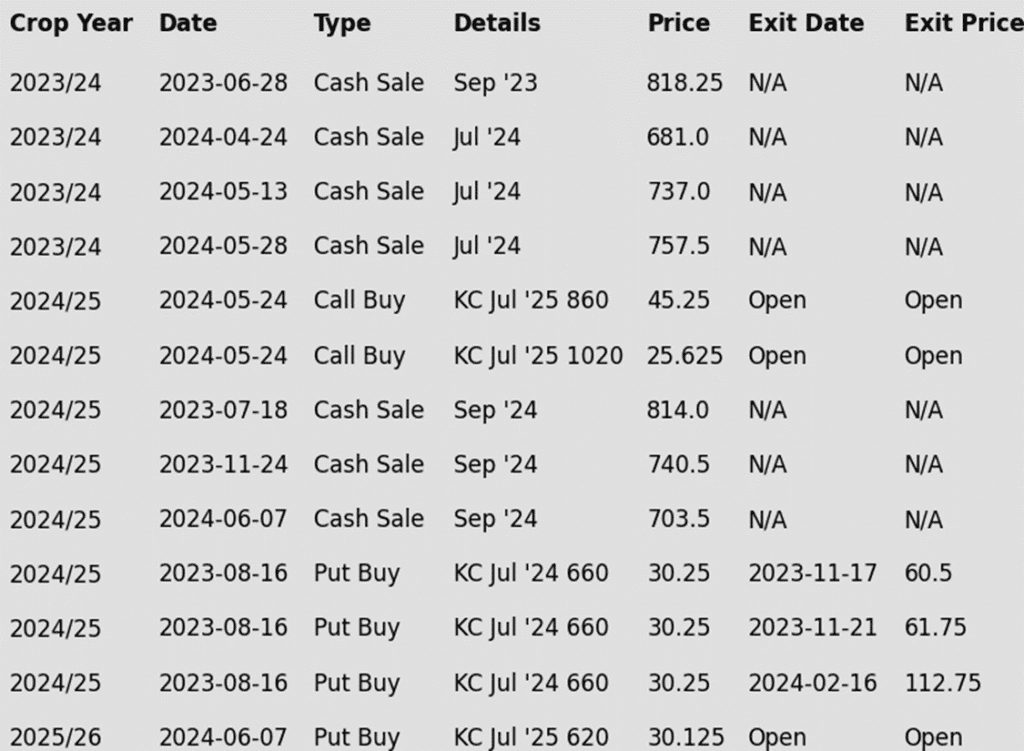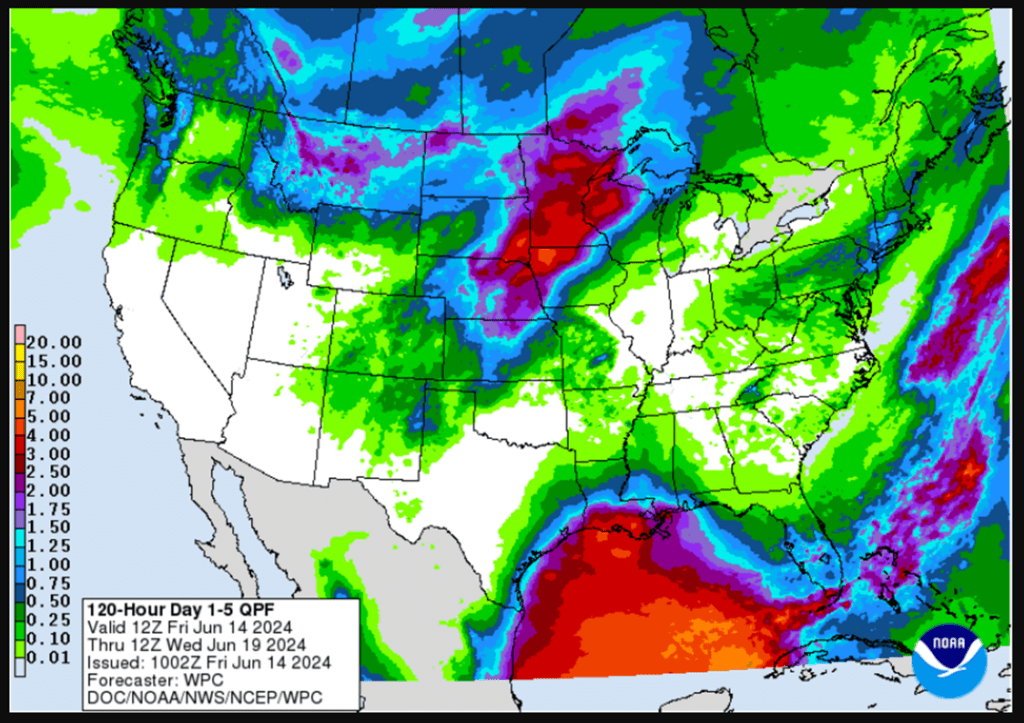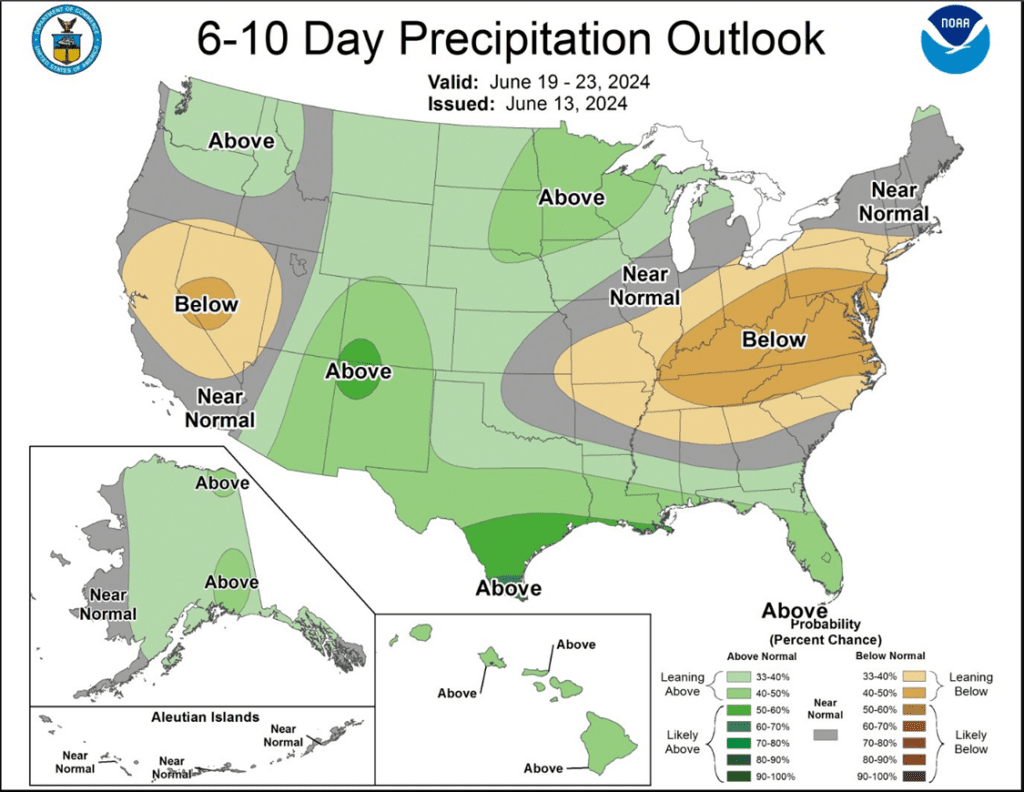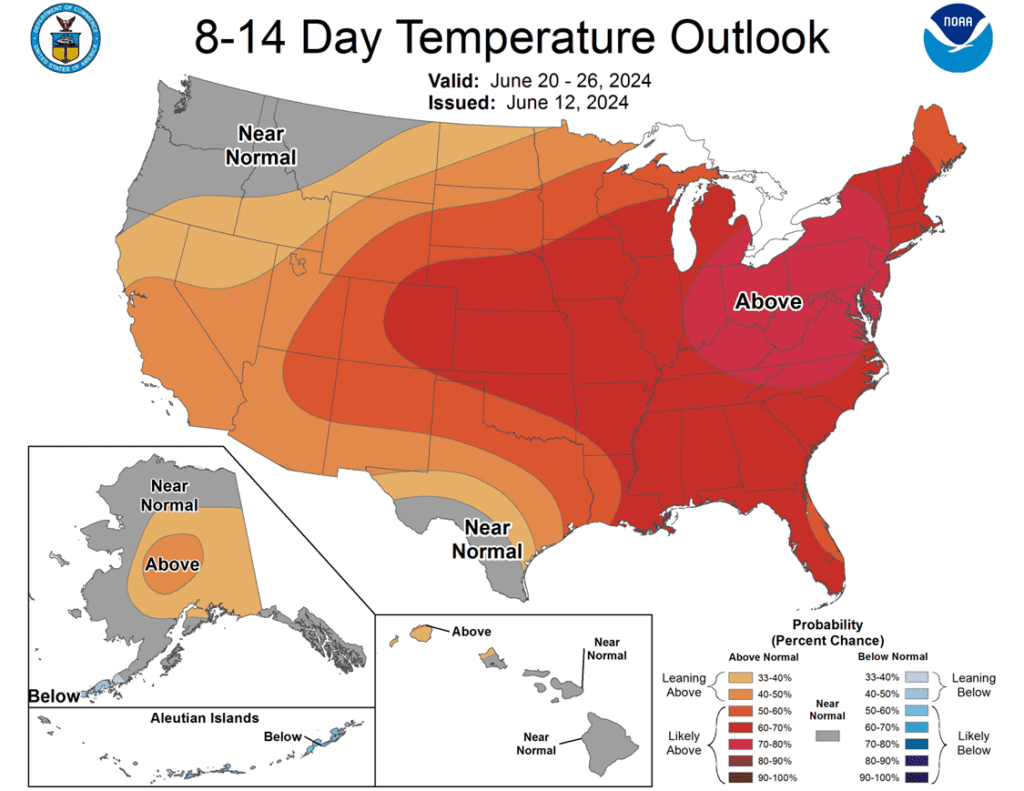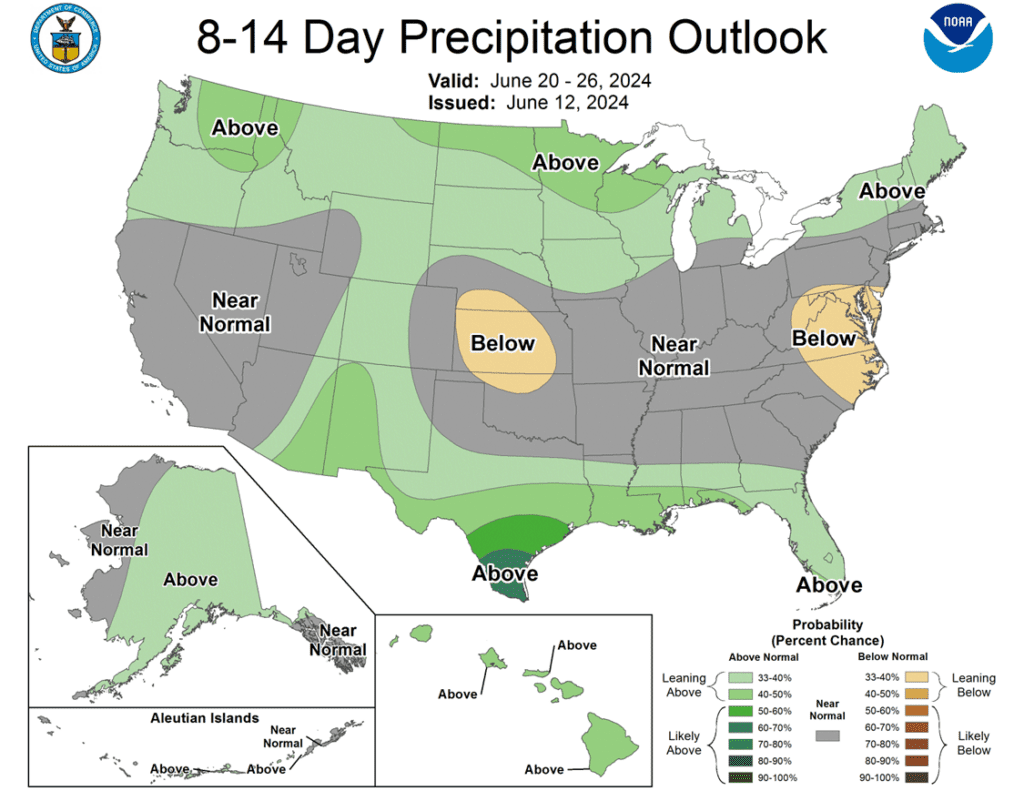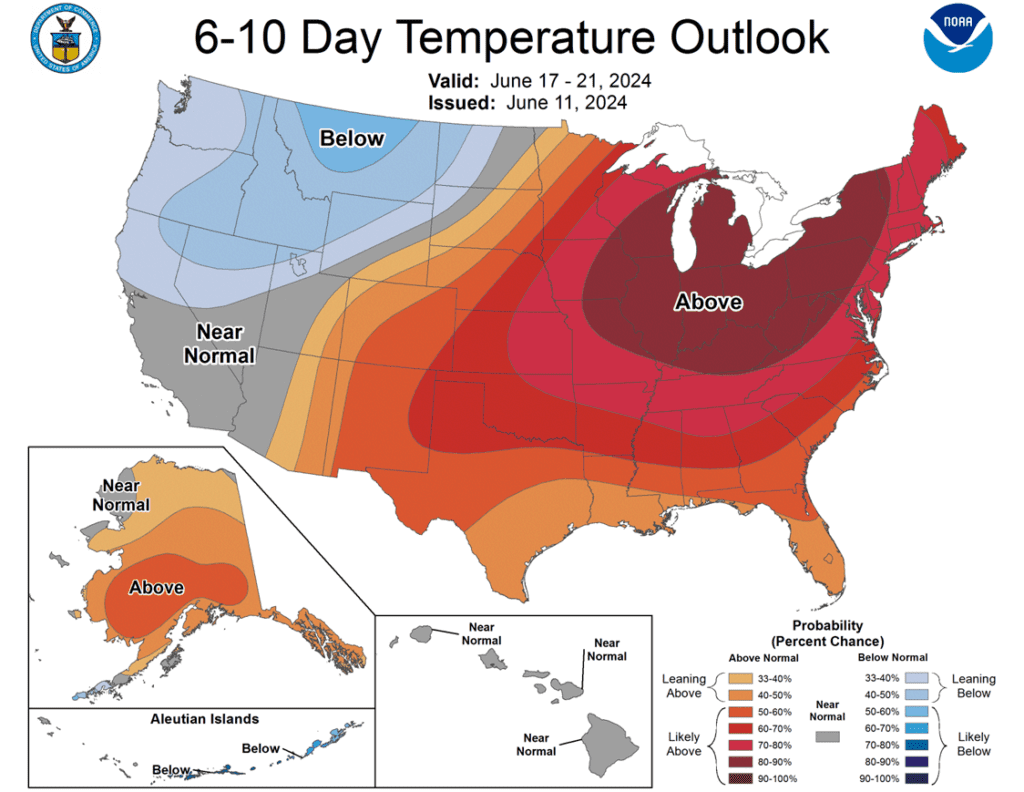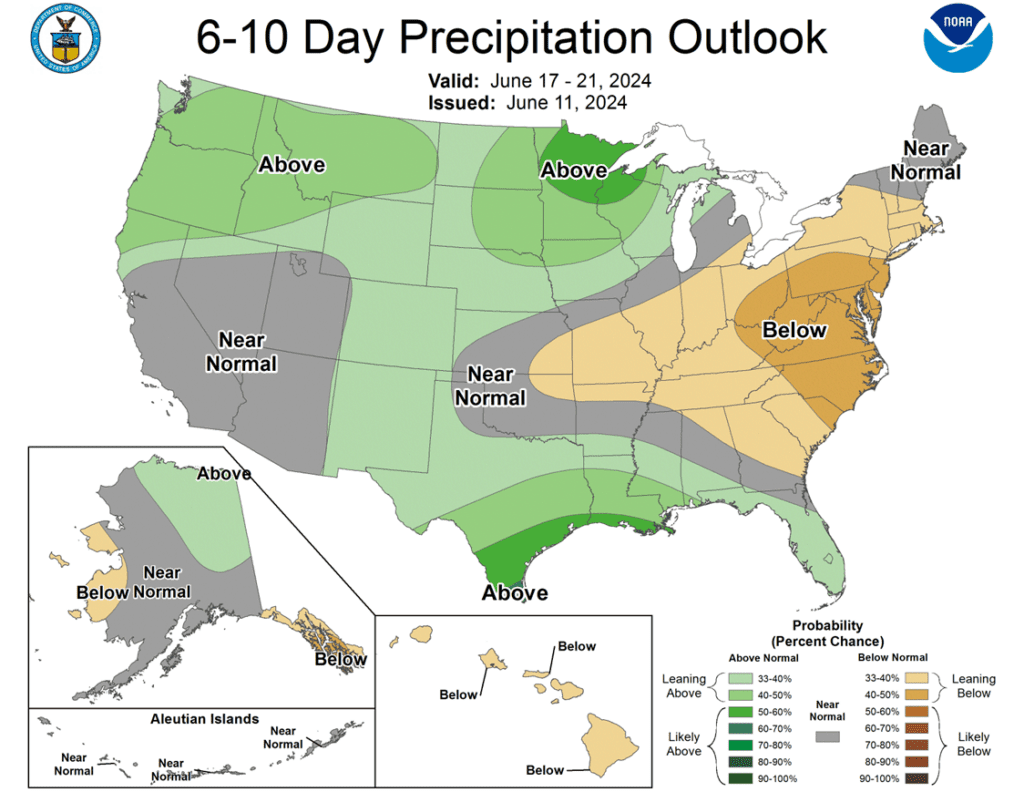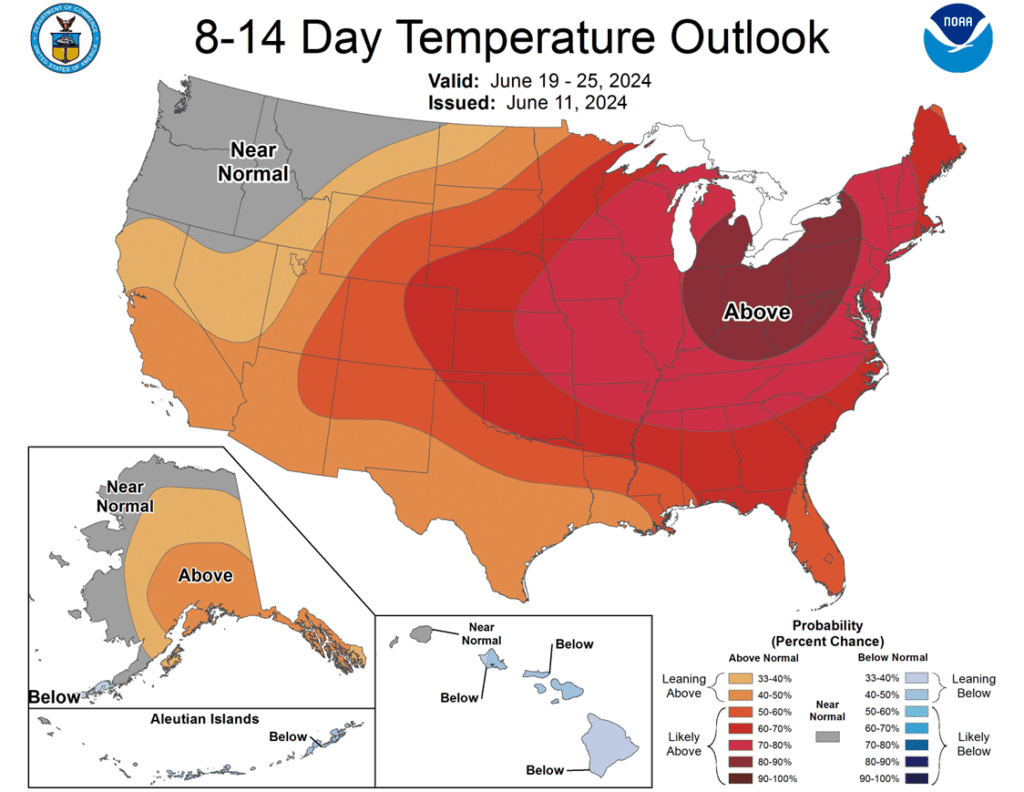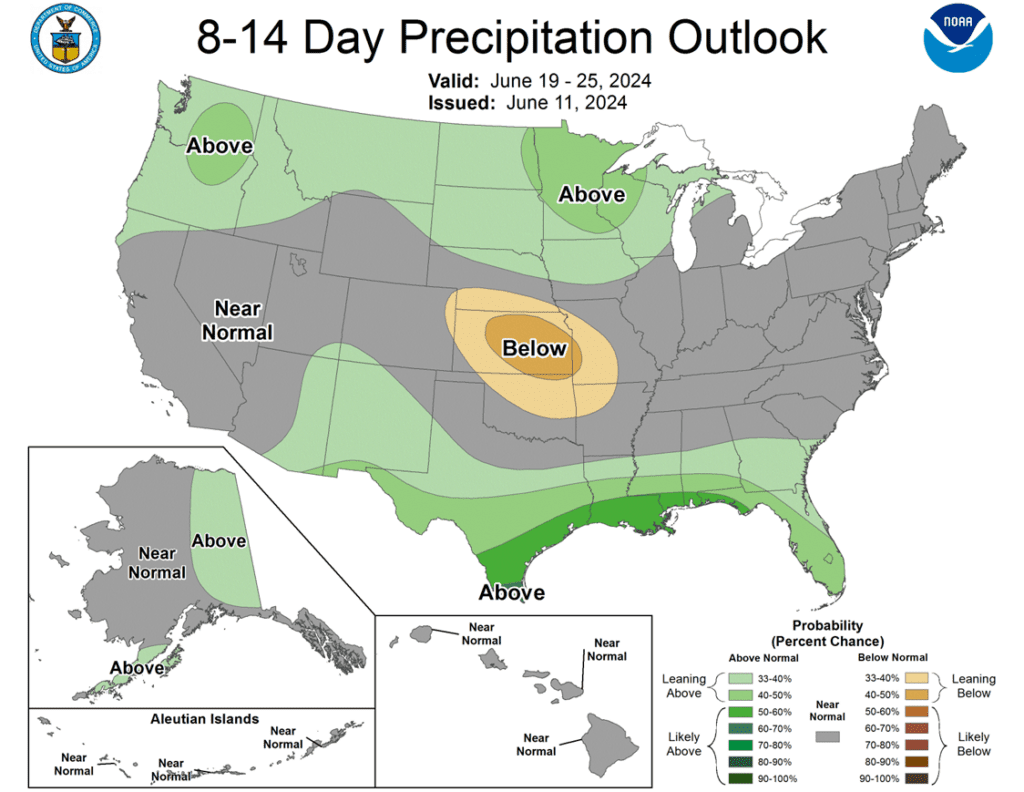6-26 End of Day: Markets Close Mixed at Midweek
All prices as of 2:00 pm Central Time
Grain Market Highlights
- Bears remain in control of the corn market as the lead months close lower for the seventh time in eight sessions. Anticipation of a potentially bearish Stocks and Acreage report and the pricing of basis contracts ahead of First Notice Day added to the negative sentiment.
- Despite trading higher in the overnight session and for much of the day, sellers took control of the soybean market aided by declines in soybean meal.
- The wheat complex settled in a mixed fashion after trading higher across the board earlier in the day, as harvest pressure remains a limiting factor, along with continued strength in the US dollar, which traded above the 106 level for the first time since May 1.
- To see the updated US 5-day precipitation forecast, and the updated US 6-10 and 8-14 day Temperature and Precipitation Outlooks, courtesy of NOAA and the Weather Prediction Center, scroll down to the other Charts/Weather section.
Note – For the best viewing experience, some Grain Market Insider content is best viewed with your phone held horizontally.
Corn
Corn Action Plan Summary
Since mid-April, the front month corn market has been in a broad trading range bound mostly by 435 on the bottom and 475 up top. While solid demand has been a prominent supportive feature of the market along with US and South American weather, an old crop carryout near 2.0 billion bushels and the prospect of an even higher carryout number for new crop, has kept upside rallies in check. The 2024 growing season is still young with lots of potential ahead as weather remains the dominant market mover.
- No new action is recommended for 2023 corn. Any remaining old crop 2023 corn should be getting priced into market strength. Grain Market Insider won’t have any “New Alerts” for 2023 corn – either Cash, Calls, or Puts, as we have moved focus onto 2024 and 2025 Crop Year Opportunities.
- Grain Market Insider sees a continued opportunity to buy December ’24 corn 470 and 510 calls in equal quantities. The Dec ’24 470 and 510 calls are about the least expensive they’ve been since each strike began trading back in 2022. Last year, Grain Market Insider also recommended buying call options ahead of the typically volatile, growing season months. Those call options proved to be invaluable as they allowed us to recommend selling into the sharp weather driven rally of June 2023, without having to worry about if the market continued to rally, like in 2012. That same call buying strategy is one that Grain Market Insider is looking to leverage now for your 2024 crop to give you the confidence to make sales into any sharp rallies.
- No new action is currently recommended for 2025 corn. As we move through the growing season with its potential for high volatility, we are looking for higher prices and anticipate issuing two more sales recommendations before the beginning of September. Also given the tendency for the growing season to provide some of the best pricing opportunities for the next crop year we will also be watching the calendar along with price action to make additional recommendations.
To date, Grain Market Insider has issued the following corn recommendations:

- Corn futures traded lower for the seventh time in the past eight sessions as July and December corn futures pushed to new lows for the recent move. July corn closed under the most recent February low as the chart continues to show technical damage.
- Bearish forces remain in the corn market and grain markets in general. Weather forecasts remain friendly for crop development, potential bearish USDA planted acres and grain stock report, overall demand concerns, and pricing of basis contracts with First Notice Day in July coming this week have helped push the bearish sentiment and price action.
- The USDA will release the Quarterly grain stocks and Planted Acres report on Friday, June 28. Expectations are for corn stocks to be nearly 770 mb over last year and planted acres to increase to 90.35 million acres. The heavy supply picture and possible acre increase are being priced in the market.
- The USDA will release weekly export sales on Thursday morning. Last week’s export sales were disappointing at 511,000 mt. The market will look for some recovery in those sales at these lower price levels.
- Weekly daily ethanol production slipped last week to an average of 1.043 million barrels/day, down 1.3% from last week. The amount of corn used for the week is estimated at 103.53 million bushels, which was below the pace needed to reach USDA targets for the marketing year.

Above: The corn market appears to be on track to test the 427 – 420 support area. If this area holds and prices turn higher, they could target 461, with potential resistance near 450 and the 50-day moving average. Should prices slide further, they may find support around the February low of 408 ¾.
Soybeans
Soybeans Action Plan Summary
Since trading toward the 200-day moving average and peaking near 1260, front month soybeans have been on the decline and appear on track to test the February low around 1128. Though domestic crush demand has been good, export demand has lagged, and like corn, the prospect of a higher 24/25 carryout looms, adding overhead resistance to prices. With much of the growing season in front of the market, a weather-related issue or surge in demand appear to be the most likely catalysts to push prices back near their recent highs.
- No new action is recommended for 2023 soybeans. As we progress into the 2024 growing season, time is becoming limited to market the remaining 2023 old crop inventory. Although we are currently targeting a rebound to the 1275 – 1325 area versus Aug ’24 futures as our Plan A strategy, for what will likely be our final sales recommendation for the 2023 crop, we also don’t want to carry old crop inventory past mid-July due to seasonal weakness. Taking this into consideration, if the market does not present the opportunity to make sales at our Plan A target, our Plan B strategy will be to issue our final sales recommendation sometime in mid-July.
- No new action is recommended for the 2024 crop. At the end of December, we recommended buying Nov ’24 1280 and 1360 calls due to the amount of uncertainty in the 2024 soybean crop and to give you confidence to make sales and protect those sales in an extended rally. Given that the market has retreated since that time, we are targeting the lower 1200s versus Nov ’24 futures to exit 1/3 of the 1280 calls to help preserve equity. Most recently we employed our Plan B strategy with the close below 1180 in Nov ’24 and recommended making additional sales due to the potential change in trend. With the growing season still ahead of us, should the market turn back higher, we continue to target the 1280 – 1300 range from our Plan A strategy to make additional sales.
- No Action is currently recommended for 2025 Soybeans. We currently aren’t considering any recommendations at this time for the 2025 crop that will be planted next year, and it may be some time before conditions are conducive to consider making any recommendations. Be patient as we monitor the markets for signs of improvement.
To date, Grain Market Insider has issued the following soybean recommendations:
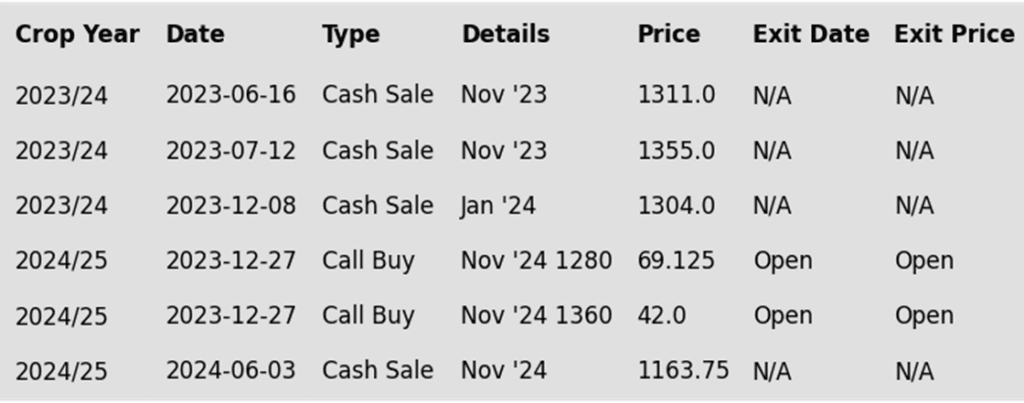
- Soybeans ended the day lower after mixed trade throughout the day which saw prices higher around midday before fading into the close with the rest of the grain complex. Pressure has been coming from a wet 14-day forecast for the central and eastern Corn Belt, and trade has seemingly ignored the potential damage done in the northwest due to flooding. Soybean meal closed lower while soybean oil was higher.
- On Friday, the USDA will release its Quarterly Stocks and Planted Acres reports. Analysts are estimating that the number of soybean planted acres will come in at 86.753 million which would be slightly higher than the planting intentions numbers of 86.510 million reported in March. Quarterly soybean stocks as of June 1 are estimated to come in at 0.962 billion bushels which would be higher than last year.
- US export demand has been sluggish with the bulk of business going to Brazil and Argentina as they remain more competitive. China has purchased some old crop soybeans but has been hesitant to purchase any new crop soybeans so far. Meanwhile, export group ANEC has reported that Brazilian soybean exports for June would reach 14.5 mmt,
- It’s estimated that funds hold a net short position of approximately 200,000 contracts between soybeans and soybean oil and are long approximately 97,000 contracts of soybean meal as of Wednesday. Yesterday, it was estimated that the funds sold an additional 10,000 contracts of soybeans.

Above: The soybean market appears to have found support around 1140. Should this area hold, and prices recover, they could then test the 1190 – 1200 area. Otherwise, they remain at risk of testing the 1130 – 1125 area.
Wheat
Market Notes: Wheat
- Early gains in the wheat market gave way to late session weakness that resulted in a mixed close. While Kansas City futures were higher across the board, Chicago and Minneapolis contracts finished on both sides of unchanged. Part of the weakness may be a result of the US Dollar Index, which rallied back above the 106 level for the first time since May 1. Harvest pressure remains a factor, running roughly double the average pace as of Monday’s crop progress report.
- Lower wheat prices may have sparked some global buying interest. Egypt bought 470,000 mt in their tender at roughly $22 per mt under their previous purchase. Russia and Romania received most of the business at 180,000 mt each, with the rest fulfilled by Ukraine and Bulgaria.
- SovEcon is reported to have reduced their estimate of Ukraine’s 24/25 wheat production by 1.2 mmt to 20.4 mmt. For reference, this is still higher than the USDA figure of 19.5 mmt. Additionally, SovEcon has said that Ukraine’s 24/25 wheat exports may drop 25% year over year to 13.6 mmt. In related news, warm and dry weather is expected to return to southwest Russia and eastern Ukraine by the end of the week.
- Canada’s 24/25 planted wheat area is expected to come in at 27.2 million acres according to a Bloomberg survey, a bump up from the 27.0 million acre estimate in March. Stats Canda will release the official data tomorrow, June 27, at 8:30 AM eastern. For reference 2023 acreage was 27.0 million.
Chicago Wheat Action Plan Summary
Since rallying nearly 200 cents from the March low to the May high, largely on fund short covering from Russian crop concerns and dryness in the southwestern Plains, prices have fallen from their peak with seasonal weakness and the onset of harvest. Although the market is showing signs of weakness, it is also becoming oversold, which can be supportive in the event prices turn back higher, and the recent breakout above the December highs suggests there is potential for a test of the 2023 summer highs post-harvest.
- No new action is currently recommended for 2023 Chicago wheat. Any remaining 2023 soft red winter wheat should be getting priced into market strength. Grain Market Insider won’t have any “New Alerts” for 2023 Chicago wheat – either Cash, Calls, or Puts, as we have moved focus onto 2024 and 2025 Crop Year Opportunities.
- No new action is recommended for 2024 Chicago wheat. Considering the recent rally in wheat, we recommended taking advantage of the elevated prices to make additional sales and buy upside July ’25 860 and 1020 calls (for their extended time frame) in case of a protracted rally. Our current strategy is to target 740 – 760 versus Sept ’24 to recommend further sales and to target a selling price of about 73 cents in the 860 calls to achieve a net neutral cost on the remaining 1020 calls. The remaining 1020 calls would then continue to protect existing sales and give you confidence to make additional sales at higher prices.
- No new action is currently recommended for 2025 Chicago Wheat. Given the weakness in the wheat market we recently employed our Plan B strategy and recommended making an additional sale as prices broke through 667 support. Moving forward, we continue to target the value of 68 cents in the July ’25 620 puts (double the original approximate cost) to exit half of the original previously recommended position, leaving the balance to continue to provide downside coverage with a net neutral cost. To take further action, our strategy is to target the 750 – 780 range to recommend making additional sales.
To date, Grain Market Insider has issued the following Chicago wheat recommendations:


Above: Chicago wheat continues to show signs of being oversold as it remains in a downtrend established in late May. Oversold conditions can be supportive if a bullish catalyst enters the scene to turn prices back higher. For now, Sept ’24 appears on track to test the 550 – 520 support area from last spring. Should that area hold and prices turn around, overhead resistance may come in around 595 – 605.
KC Wheat Action Plan Summary
Since the end of May the wheat market has been trending lower as concerns regarding Russia’s shrinking wheat crop have waned, along with US HRW harvest yields being higher than expected. During this time the market has become extremely oversold, and managed funds have begun reestablishing their short positions. While harvest pressure and falling Black Sea export prices continue to weigh on US prices, the funds’ short position and oversold conditions could culminate in a short covering rally on any increase in demand as world wheat ending stocks are expected to fall yet again this year.
- No new action is recommended for 2023 KC wheat. Any remaining 2023 hard red winter wheat should be getting priced into market strength. Grain Market Insider won’t have any “New Alerts” for 2023 KC wheat – either Cash, Calls, or Puts, as we have moved focus onto 2024 and 2025 Crop Year Opportunities.
- No new action is recommended for 2024 KC wheat. Considering the recent upside breakout in KC wheat, we recommended buying upside July ’25 860 and 1020 calls (for their extended time frame) in case of a protracted rally. Our current strategy is to target 780 – 810 versus Sept ’24 to recommend further sales and to target a selling price of about 71 cents on the 860 calls to achieve a net neutral cost on the remaining 1020 calls. The remaining 1020 calls would then continue to protect existing sales and give you confidence to make additional sales at higher prices.
- Grain Market Insider sees a continued opportunity to sell half of the previously recommended July ‘25 620 KC Wheat puts at approximately 60 cents in premium minus fees and commission. Earlier this month Grain Market Insider recommended buying July ’25 620 KC wheat puts for approximately 30 cents in premium plus commission and fees to protect the downside from further potential price erosion. At the time, July KC wheat had just broken through support near 706. The breaking of 706 support increased the risk of the market retreating further. Since that time July ’25 KC wheat has dropped about 90 cents, with the July ’25 620 KC wheat puts having roughly doubled in value. Though prices are depressed following this market drop, plenty of time remains to market the ’25 crop, with plenty of unknowns remaining that could rally prices. Grain Market Insider recommends selling half of the previously recommended July ’25 620 KC wheat puts to lock in gains in case prices rally back and holding the remaining puts at or near a net neutral cost, which should continue to protect any unsold bushels if prices erode further.
To date, Grain Market Insider has issued the following KC recommendations:


Above: It appears that support has been found around 576. If this area holds and prices turn back higher, initial resistance could be found near 620 with heavier resistance up towards 650 – 660. If the 476 area doesn’t hold, they may find further support between 570 – 550.
Mpls Wheat Action Plan Summary
Since the end of May, the wheat market has been trending lower as concerns about Russia’s shrinking wheat crop have eased and US HRW harvest yields have exceeded expectations. During this period, the market has become extremely oversold, leading managed funds to reestablish their short positions in Minneapolis wheat. Although declining Black Sea export prices and slow world demand continue to depress US prices, the funds’ short positions and oversold conditions could trigger a short-covering rally with any increase in demand, especially as global wheat ending stocks are projected to decline again this year.
- No new action is recommended for 2023 Minneapolis wheat. Any remaining 2023 spring wheat should be getting priced into market strength. Grain Market Insider won’t have any “New Alerts” for 2023 Minneapolis wheat – either Cash, Calls, or Puts, as we have moved focus onto 2024 and 2025 Crop Year Opportunities.
- No new action is recommended for 2024 Minneapolis wheat. With the recent close below the 712 support level, Grain Market Insider implemented its Plan B stop strategy, recommending additional sales for the 2024 crop due to waning upside momentum and an increased likelihood of a downward trend. Given the heightened volatility and the amount of time that remains to market this crop, we will maintain the current July ’25 KC wheat 860 and 1020 call options. Our target is a selling price of about 71 cents for the 860 calls to achieve a net neutral cost on the remaining 1020 calls. These 1020 calls will continue to protect existing sales and provide confidence to make additional sales at higher prices.
- Grain Market Insider sees a continued opportunity to sell half of the previously recommended July ‘25 620 KC Wheat puts at approximately 60 cents in premium minus fees and commission. Earlier this month Grain Market Insider recommended buying July ’25 620 KC wheat puts for approximately 30 cents in premium plus commission and fees to protect the downside from further potential price erosion. (KC puts were recommended for Minneapolis due to KC wheat’s greater liquidity and high correlation to Minneapolis wheat.) At the time, July KC wheat had just broken through support near 706. The breaking of 706 support increased the risk of the market retreating further. Since that time July ’25 KC wheat has dropped about 90 cents, with the July ’25 620 KC wheat puts having roughly doubled in value. Though prices are depressed following this market drop, plenty of time remains to market the ’25 crop, with plenty of unknowns remaining that could rally prices. Grain Market Insider recommends selling half of the previously recommended July ’25 620 KC wheat puts to lock in gains in case prices rally back and holding the remaining puts at or near a net neutral cost, which should continue to protect any unsold bushels if prices erode further.
To date, Grain Market Insider has issued the following Minneapolis wheat recommendations:
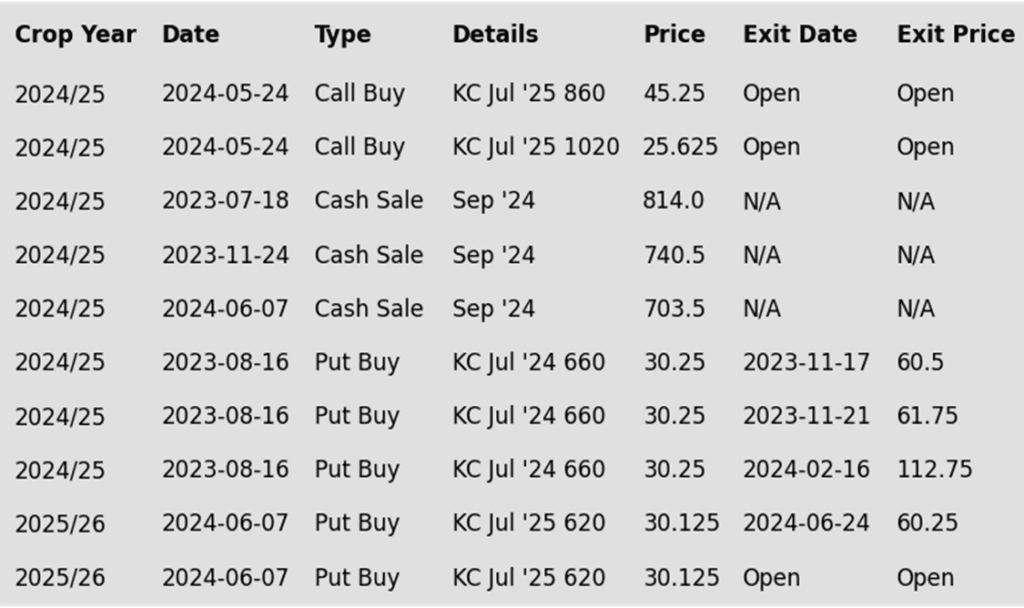

Above: September Minneapolis wheat is extremely oversold, which could be supportive if prices turn higher. In that case, resistance may be encountered near 650. Otherwise, prices might be on track to test support around 600.
Other Charts / Weather
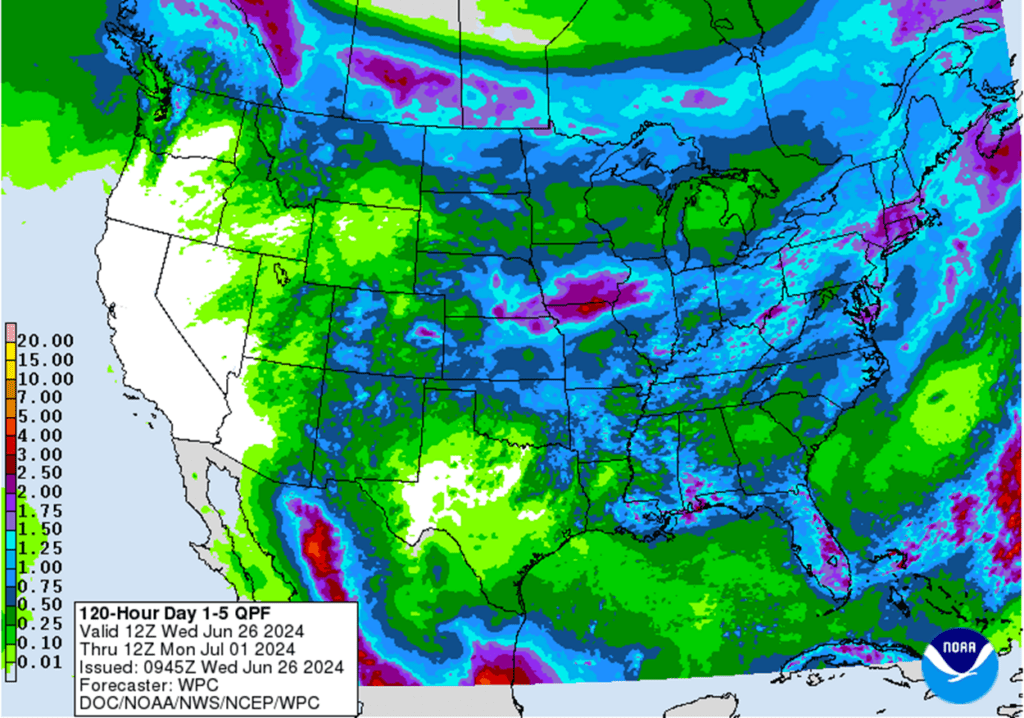
Above: US 5-day precipitation forecast courtesy of NOAA, Weather Prediction Center.
